Is There A Way To Get Rid Of The Ads On The Magic Puzzle App
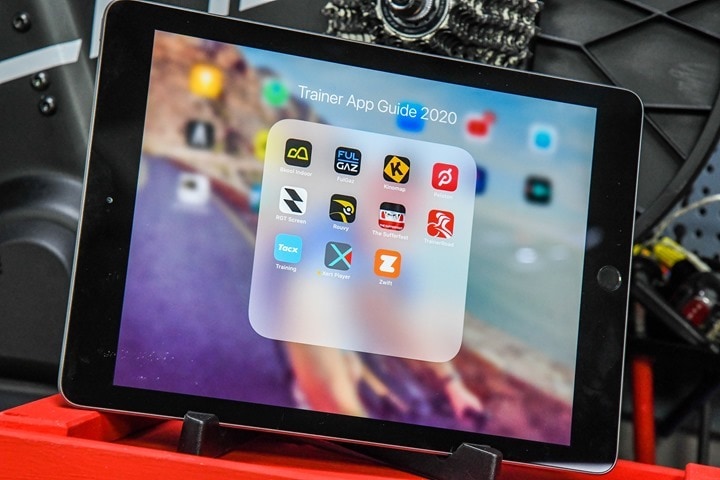
It's been three years. Which is roughly how long I needed to recover from writing the last one of these things. While I had planned to write this last fall, that didn't happen. But now that a lot of us are either stuck indoors, or about to be, it's as good a time as any. So welcome to The Beast of a round-up.
This time though, I'm simplifying it a bit. Last time I covered some 20 different apps. While many of those apps do still exist and are now more mature, I'm going to focus this round-up on what I believe to be the Top 11 indoor trainer apps. With that metric largely being driven by the userbase, and how often I actually hear people talk about it.
As much as every company wants to tell me their app is most important, I tend to find if nobody is talking about it…then nobody is actually using it. It's a surprisingly simple concept. In the case of 2020, it's all relative. With Zwift at more than 300,000 users, the stakes are higher – as is the baseline.
So, without further ado – here's what I'm covering this time around, in alphabetical order (use the left sidebar to quickly skip to a different app):
– Bkool
– FulGaz
– Kinomap
– Peloton Digital App (sans-Peloton Bike)
– RGT (Road Grand Tours)
– Rouvy
– The Sufferfest
– Tacx Training App
– TrainerRoad
– Xert
– Zwift
One could likely argue for PerfPro, or Golden Cheetah. Perhaps Kinetic Fit. Maybe CVRcade. One might also suggest OneLap – though given my readership here is 99.9% not in China, and that platform is 99.9% catered to the Chinese market (albeit with some rough translations for some parts in English). Then there's apps that are much smaller, but still might be cool for a follow-up in future weeks. For example some of the one-person developer type apps like Arcade Fitness or The Velo Set, or a handful of others.
Ultimately, as I said before that I could try and get everyone on this guide, but then the guide wouldn't ever happen. And while I'm sure someone from missed apps may disagree, I think this is by far covering every one of the major and middle players of apps people are using these days. Oh, and finally – I paid for access to all these apps myself, or used their various 14-30 days free trials. None of this is sponsored in any way, shape, or form. In fact, I pay these companies as part of my monthly subscriptions, just like you. That's just the way I roll.
What you'll need:

It probably goes without saying that you're going to need some sort of indoor trainer here. But it doesn't have to be an expensive one. Virtually every one of these apps will actually work with so-called 'dumb' trainers, ones that don't have any smarts at all. Ones you might have laying around in your garage from a decade ago. Most of these apps will have those models in there and you'll be up and running with usually nothing more than a speed sensor.
Still, a lot of you will have (or want) smart trainers. I've got a separate post on that with all my recommendations. Go check that out, it's just as detailed as this post, except it's about trainers instead of apps. From budget to expensive smart trainers, and my favorite accessories, it's in there.
Finally, you're going to need something to run the apps on. A computer, a phone, a tablet, perhaps Apple TV. Whatever it is, you'll need at least one device. Each app varies on what platforms they support, but the vast majority of apps today support at a minimum iOS and Android, or Windows and Mac. Some apps even require two pieces of hardware (such as a phone + a bigger screen device). We could go beyond that and talk about how to get this stuff up on a big screen TV, and I did that a few years ago too, but for now, we'll just focus on the apps themselves.
With that – let's get straight into the apps. Again, they're all ordered alphabetically, and you can use the navigational sidebar to skip ahead to the different chunks.
Bkool:
Back in the old days, Bkool sold hardware. These days though, they divested their hardware business last fall, and now focus exclusively on software. Training software to be precise. And actually, they've got two different apps. One app is essentially the Bkool that you know and love from yesteryear with races, group rides, outside video rides, VR rides, etc… While the newer secondary app is basically a blend of Peloton and structured workouts, with a substantial amount of Spanish classes.
I'm going to mostly focus on the more typical trainer app here, though I'll briefly touch on the other bit. If you buy a full subscription, you get access to both. The logic behind splitting it out is that the more casual fitness crowd that's using the Bkool Fitness app isn't likely to need all the very bike-specific features like racing or more complex structured workouts of the Bkool Indoor app. In any event, here's the main homepage of the Bkool Indoor app:
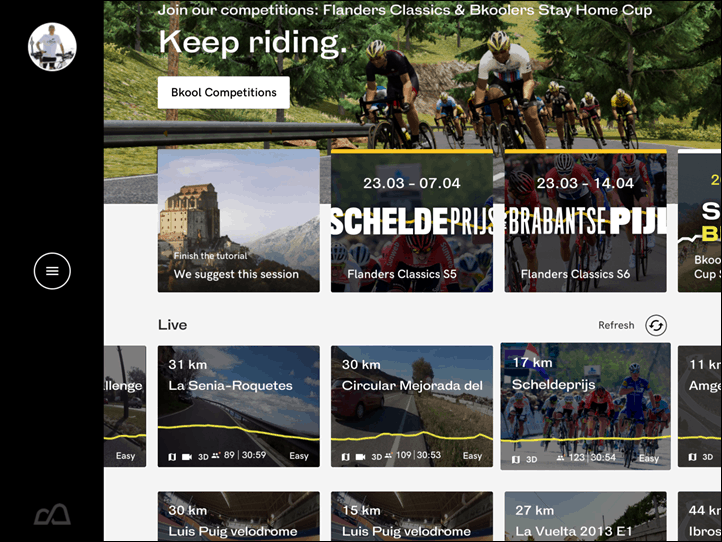
At first glance you might assume it's all videos, but in reality, each one of these videos is actually a threesome: It's a video, a 3D representation of the world (à la Zwift), and then a map-view of the world. Don't worry, we'll get there in a second.
But wait, there's more. For some odd reason they split out the non-live events into a separate page that you don't realize is there till you go into the search panel, then you'll see the other four sections. Some of these have boatloads (like, thousands) of options within them. For example if I open up the Routes one, and then select 'The Whole Catalogue', then I see tons more:
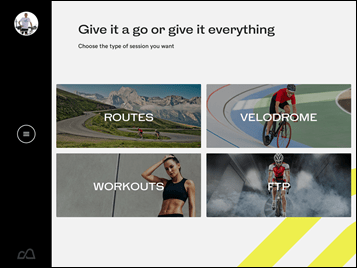
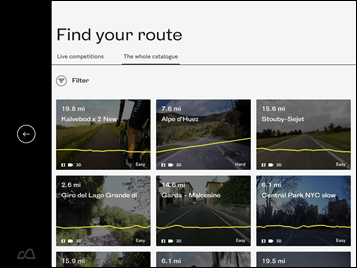
And the same is true of 'Workouts', and then there's a handful in the Velodrome games folder:
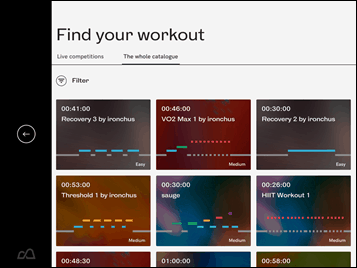
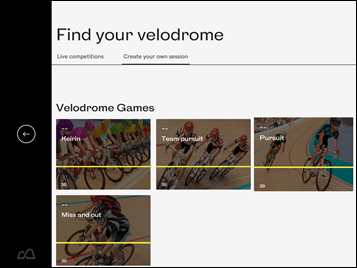
In any case, we'll back up to the main dashboard first. These are sorted first by those that are live events, with other real-world people. Aside from Zwift and Peloton, there's no other platform that comes even remotely close to the live user numbers you see here. Many of the recent nights I logged in, a number of the live events had 100+ people in them (though, Bkool says the app might struggle at over 100 people in a given race). During the daytime, most of them had around 20-30 people in them. The fact that I'll predominantly show a live event is mostly to get the most bang for my buck text-wise here. If you choose one of the non-live videos above, it's all the same (minus other people).
If you tap on one of them you'll see information about it, including a course map and elevation plot. You can also poke at the settings as well as the other racers in the course currently:
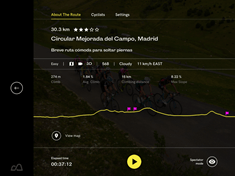
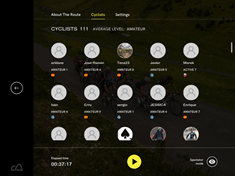
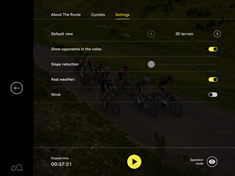
From a sensor pairing standpoint, Bkool seems to support all the normal stuff you'd expect. Smart trainers, power meters, speed sensors, cadence sensors, and HR monitors. Depending on which platform you're on, that'll be both ANT+ & Bluetooth Smart.
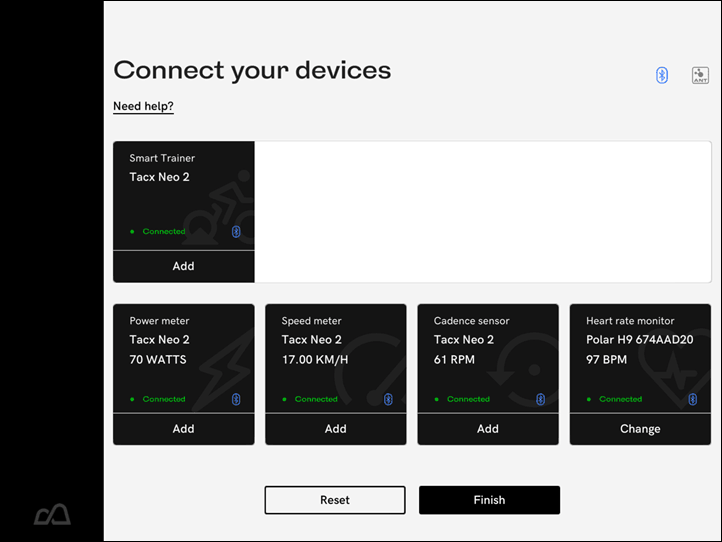
Once you've got those paired up (which it saves for next time) we'll go ahead and start one of the sessions. By default, it'll start in the 3D Terrain view, but you can change that (both the default, and the current view):
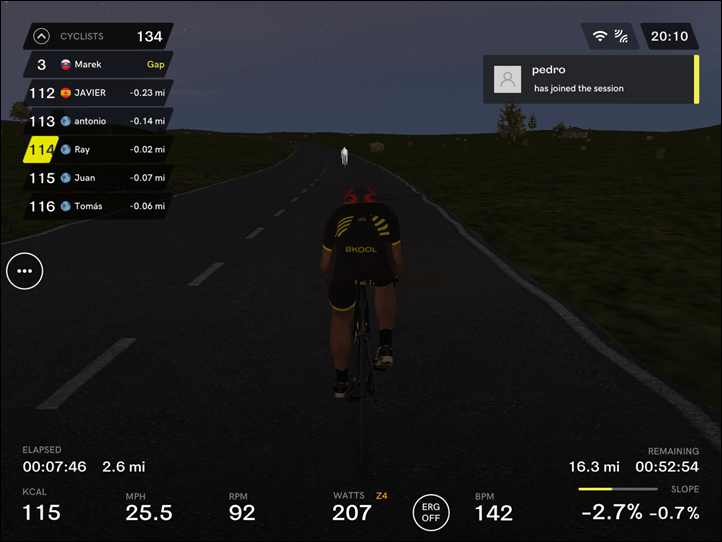
If you want to change to either the video view or the map view, simply swipe across the screen:
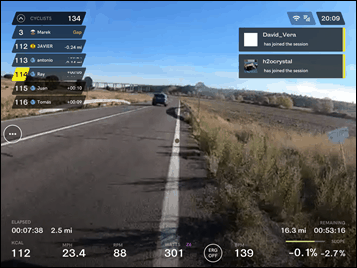
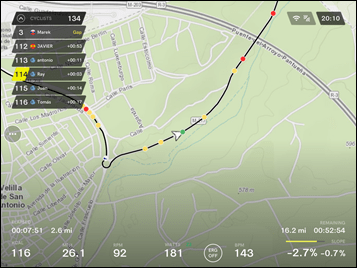
Back in the video view, the replay of the video will match your speed. You'll also see competitors along the left side, and then down below you've got all your stats and time/distance remaining. Up top in the right it'll notify you of people entering the event. I couldn't find any obvious way to turn-off those entry notifications, which got a bit annoying after a while. Perhaps it's hidden somewhere.
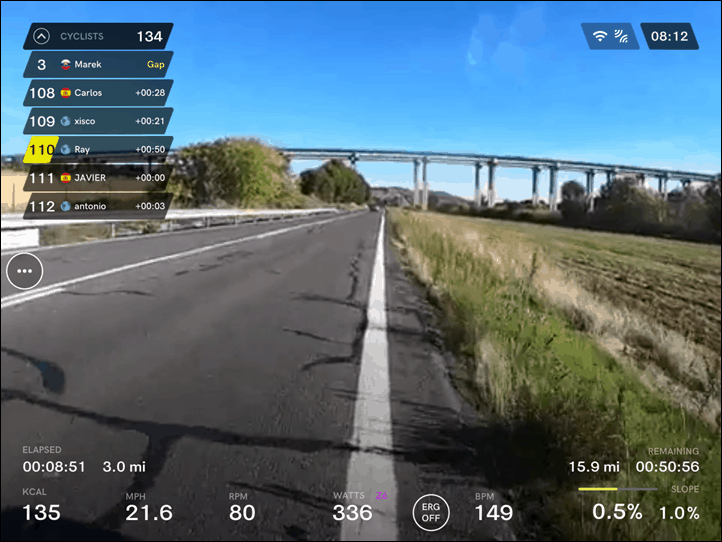
Next is the 3D Terrain view. This is loosely modeled after the terrain you see in the video, but definitely loosely so. Sometimes the two lined up really well (primarily in fields and such with bridges or what-not). Whereas other times in towns it just showed a field, or vice versa. The other thing is that the time of day didn't really match. So I rode at night in the 3D Terrain view, while it was daytime in the video. To have things match realism-wise, I'd think it'd just match the video. Still, that's probably nitpicking a bit. Within the 3D Terrain view you'll see your competitors on the screen, just as you would in Zwift:
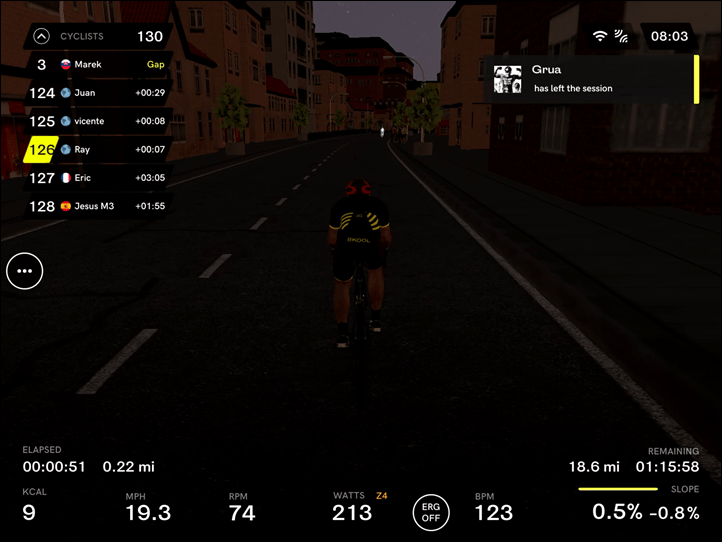
Lastly there's the map view. This can be changed from satellite to terrain to standard map view within the app settings prior to starting. You'll see your competitors on the map, allowing you to formulate just how viable that totally unrealistic gap is to close.
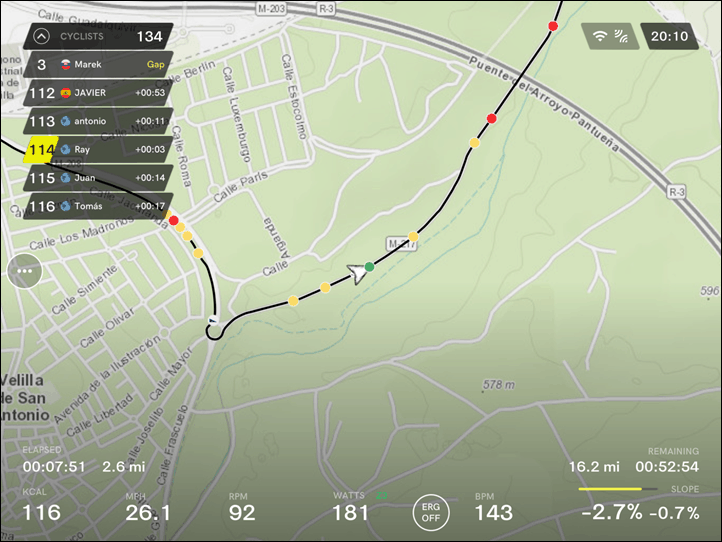
Now, the one caveat I've got is that this was the *only* app during my review period to crash mid-ride. Which isn't to say I've never had other apps crash. Certainly over the years I've seen Zwift and others have a bad day. But, given I was mostly focusing on comparison of apps in the last couple weeks, this one did crash mid-ride. However, it also did recover my ride and let me resume a few moments later. I did also find that swiping between the 3D and Video view would result in some weird lag/speeding up. It'd usually sort itself out in a few seconds, but it could probably use a bit of refinement.
Next, over on the Bkool Fitness side, this is where you'll do any structured workouts you want. These could be instructor-led, or they could just be structured workouts atop pretty scenic ride videos:

If you crack one open you'll see the exact structure of the workout:
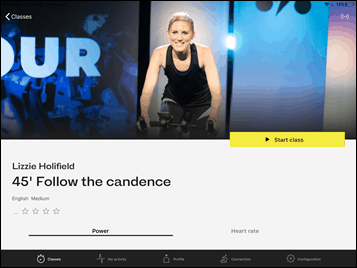
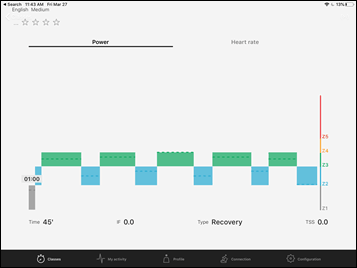
You can pair a power meter or a heart rate strap here, but not other sensor types like a smart trainer or cadence sensor, which is honestly a bit weird since they already have that code based in the other app. Seems like a silly limitation.
Note that you can still go back into the Bkool Indoor app and do structured workouts there though (sans-video) with a smart trainer/cadence sensor:
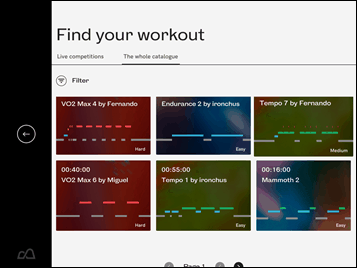
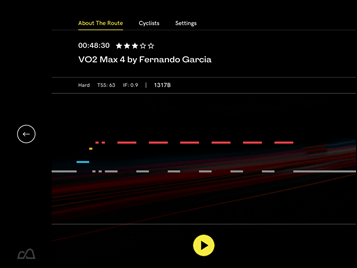
Finally, the last piece of the Bkool puzzle is their Video Editor, which allows you to upload your own videos to the platform. So if you've got a GoPro on your bike, you can go out and record a ride, and then re-ride it in the app later on. This feature is free to use, and allows you to share rides/routes with your friends.
Phew, ok – I think we've reached the end. BKool is a huge platform, once you manage to find all the pieces. On one hand, by showing the live events upfront and center (and hiding the non-live events behind a few more taps), the company has managed to significantly increase the community and social aspect of the app. And with the huge subscription numbers they have, that strategy seems to roughly be working. Still, I wonder how many people don't realize large parts of the platform are buried in the app, or on the secondary app they might not even have installed.
Still, it's definitely worth a whirl – and I'd say especially so if you're Spanish speaking, given the number of classes that are available in Spanish.
FulGaz:
If you're one of those types of peoples that just wants to ride beautiful outdoor rides, from the comfort of your sketchily compiled pain cave – FulGaz is probably the one to be at. While other applications like Rouvy and Kinomap undoubtedly have more rides, the rides on FulGaz, in general, tend to be highly curated. I personally use the Apple TV variant of FulGaz, which I'd also argue is the cleanest Apple TV trainer app out there, from a user interface standpoint.
To get started you'll be presented with a huge swath of outdoor rides to choose from. They've got various categorizations so you can flip through Netflix style until you find the end of the internet:
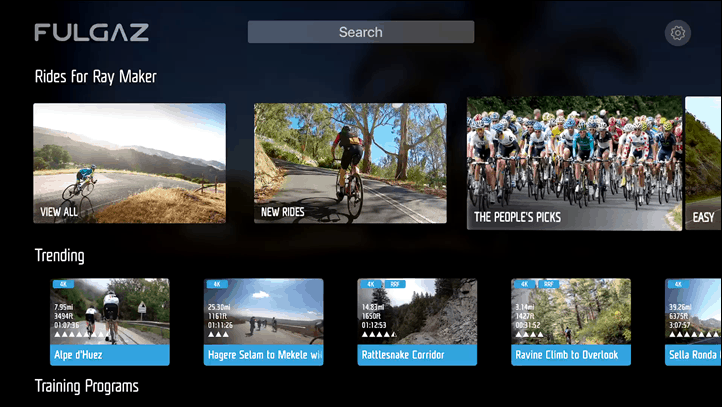
You can also favorite certain ones, and pre-cache the video download, including in 4K. Heck, for those geeks among us, you can even pre-cache them onto a local NAS server if you want to. The 4K bit is notable because apps like Zwift don't actually render in 4K on Apple TV 4K, whereas this does. Cool stuff.
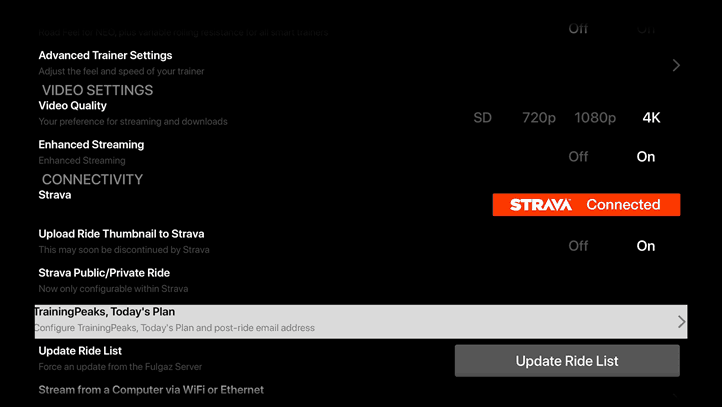
When it comes to sensors, the app supports everything out there that you're likely to use, from power meters to smart trainers, and heart rate straps too. They've also done a fair bit of work behind the scenes with the Wahoo KICKR CLIMB to really nail that experience. They do that by using a more advanced version of Wahoo's CLIMB API, to send the commands just a tiny bit ahead of the trainer, so that what you see on the app matches what you feel in your legs precisely. It might sound like a silly nuance, but if you ride FulGaz on a constantly hilly course, and then ride some other app on a similar course – you'll immediately notice how much more realistic FulGaz feels. Might also explain why Wahoo often will use FulGaz on KICKR CLIMB demo stations at trade shows.
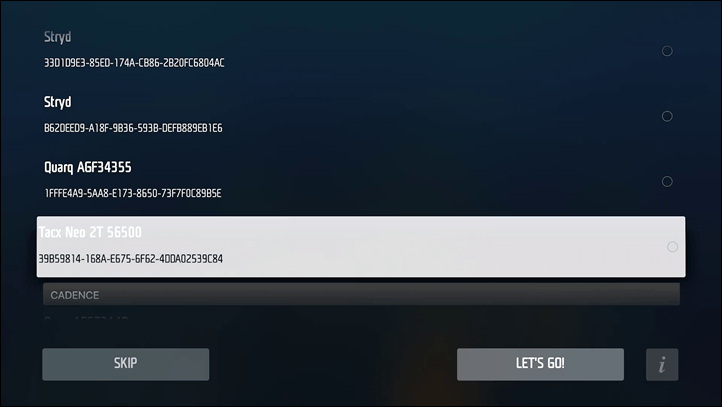
Once you pick a course you'll see the course profile and a few tidbits. And again, the ability to download it to your cache (to guard against any connectivity issues if you have a sketchy internet connection).

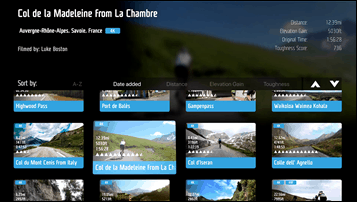
After that, simply hit go and get rollin'. The app shows all your power/HR/cadence/etc metrics, and even will show gearing for certain smart bikes. Again, we see FulGaz lead the way here showing gearing for the Wahoo KICKR Bike, something no other app to my knowledge has implemented yet.
The video playback speed will vary based on your output. In general, the vast majority of these videos are shot on a bike, with special GoPro camera setups and then post-processed to make them pop a bit more. Most look really good. As with Rouvy and Kinomap, there is the occasional case where your speed is faster or slower than the filmed recording speed, so you might see quirks there – but I find that tends to be somewhat more rare here than the other apps. Perhaps because FulGaz is a bit more selective in their uploaded routes. Or maybe the people filming it more closely match my normal speeds.
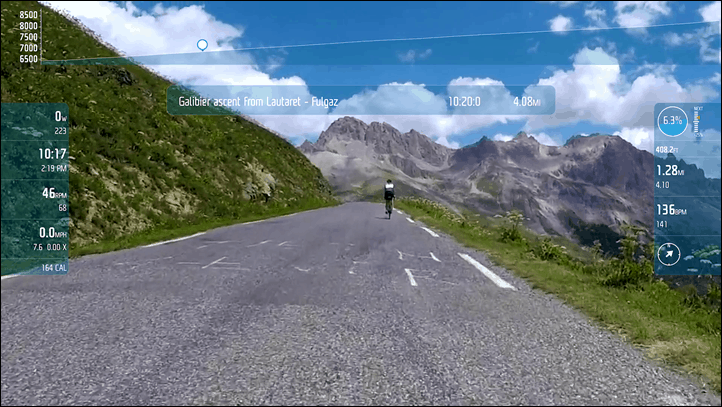
When it comes to post-ride functions, your data will share up to all the usual platforms you'd want it in. So Strava and such. And depending on your settings you can also receive a .FIT file with your ride too. Also, as with the ability to load files on a NAS server, the geeks in the house will find plenty of tweakable features deep in the settings – including things like playing with virtual road resistance (Crr). So the beauty is more than just skin deep here.
As I said early on – pretty outdoor rides is really FulGaz's bag. However, they do also have some 12-week training programs in the app as well. These include a climbing focused program and an FTP focused program. The plans include a blend of scenic rides within FulGaz, matched with a structured workout that overlays atop the screen.
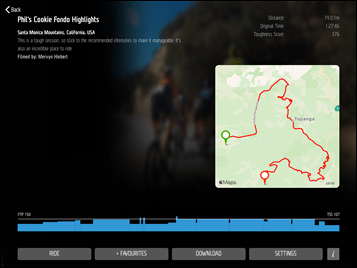
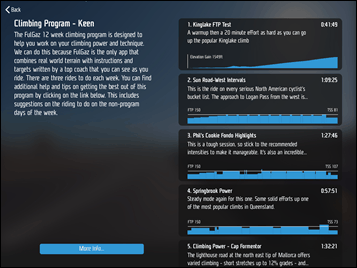
There isn't a massive amount of depth to these structured workouts or the numbers of them, but hey, they are there for those that want to be a bit promiscuous from time to time away from the scenic rides.
Ultimately, I like having FulGaz in my pile of apps I can dig into, and with boatloads of rides to choose from (you can actually see the entire list here), many of them exceptionally long climbs, you won't go bored anytime soon.
RGT (formerly Road Grand Tours):
It's been roughly a year since Road Grand Tours rebranded to RGT Cycling. As part of that rebranding they also overhauled their app platform and made it more widely compatible. RGT as an app allows you to ride and race against other competitors in virtual worlds that mirror real life locales. These include places like the famed Cap Formentor in Mallorca. Plus some city spots like Canary Wharf in London. All in, there are 8 different worlds you can choose.
However, before we start that, we gotta get the app installed. Twice. See, as part of that overhaul I mentioned, RGT split up the app into a 'Screen' app and a 'Companion' app. And it requires both, on two separate devices. So you'll need both your phone and another device like a tablet, computer, or Apple TV. While I agree that in practice, most people probably use two devices while they're on the bike anyway. But in principle, it's just annoying AF – especially if you just want to simply use a tablet:
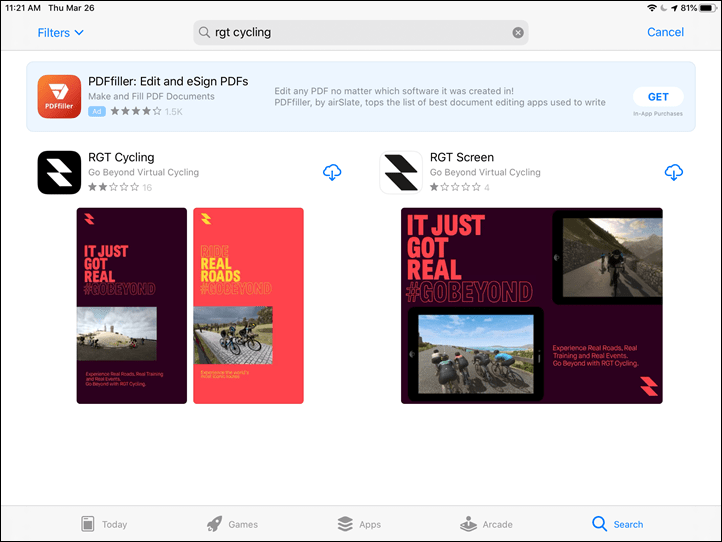
Now some of you might say 'But Zwift has a companion app too, how's this any different?!?'. Well, namely in that the regular Zwift app can operate just fine without the companion app running. RGT can't.
The 'RGT Screen' app is where you'll view the game, whereas the 'RGT Cycling' app is how you'll control the screen app. It's sorta like a remote. In my case I predominantly used the RGT Screen app on my Apple TV, while the RGT Cycling app lived on my phone. The screenshots here are from a blend of the RGT Screen app on both Apple TV & iPad. You'll pair up the two parts by putting in a simple four digit pin:
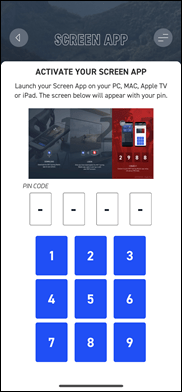
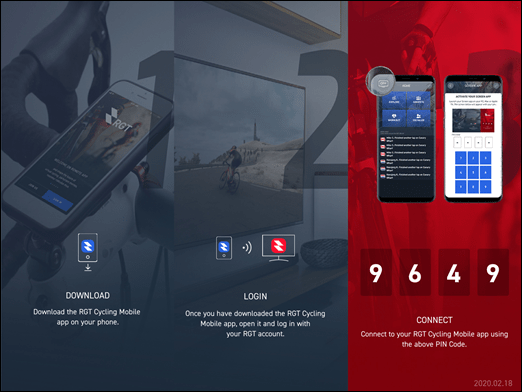
Once that's done, you'll use the companion app to navigate the menus of the screen app. You can't touch your iPad and navigate things, you have to use the phone. In any event, RGT has basically two core categories of routes: 'RGT Real Roads' and 'Magic Roads'. With Real Roads, it's one of the aforementioned re-created routes. Whereas Magic Roads allows you to e-mail in a .GPX file and they'll recreate the route in the app on the fly (the turns and elevation primarily). Here's a quick gallery of all those routes:
In total the routes offered are:
– Cap Formentor, Spain
– Mont Ventoux, France
– Borrego Springs, USA
– Passo dello Stelvio, Italy
– Pienza, Italy
– Paterberg, Belgium
– Canary Wharf, UK
– 8bar, Germany (short 1KM crit course)
Once you've picked a route, you'll go ahead and be able to start it, joining others on the platform. Up until the last week, the number of people on RGT was dismally bad. Like, virtually none (I know, they'll say otherwise, but realistically it was empty except for bots). Last week it started getting better, and as of earlier today, it's not too bad. Most of the courses mid-day European time have 20-30 people on them. You can see side by side my companion app with the screen app. However, there have been some cases in the last few days where it's showing upwards of 100+ people on a given course.
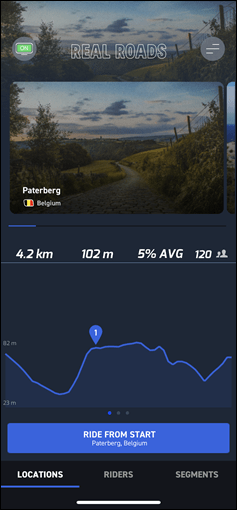
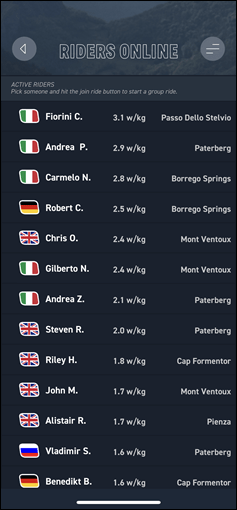
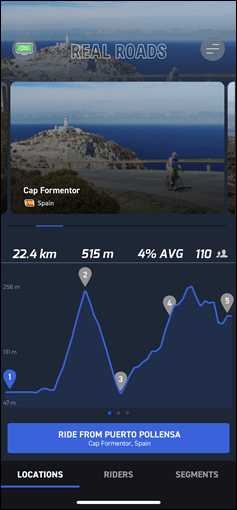
Once you're in a ride there's some basic controls on the companion app to wave at people, change the camera angle, and tweak the on-screen display elements. Plus chat.


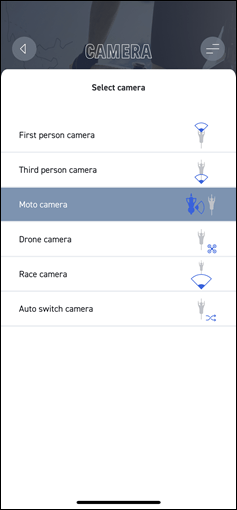
There are elements of RGT that are more realistic than Zwift, and yet others less so. For example, when you corner in RGT, your avatar actually slows down, versus Zwift it just screams through the corner like a drunk rider. Inversely, I find more graphical quirks in RGT – random rendering type issues that I don't see as much in Zwift.

In terms of realism, that too depends, and people's opinions vary. I think on a hugely spec'd out machine RGT will probably look better than Zwift on certain courses. However, for run of the mill iPad and Apple TV implementations, I think Zwift tends to pop a bit better.
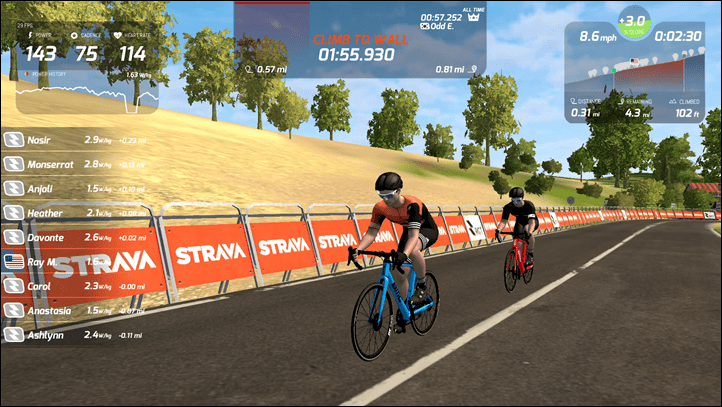
That said, RGT aims to replicate a given route outside, whereas even in Zwift's re-creations of certain courses they take varying degrees of creative liberty with structures and such nearby the courses. Again, to each their own.
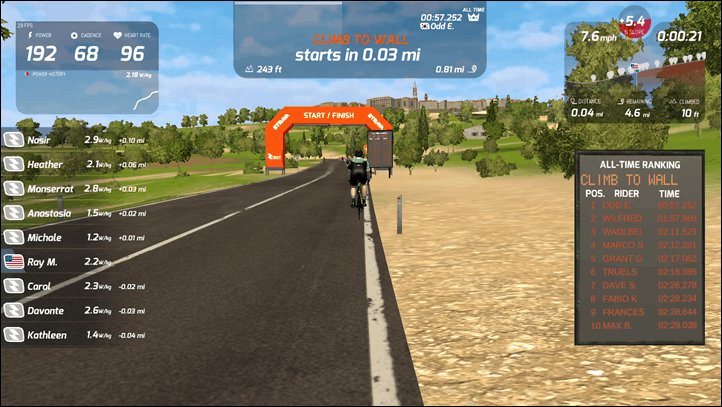
RGT has races that are roughly every few hours. So that's less frequent than Zwift, but that's probably a good thing to ensure people in them. More notably though is that RGT has done a better job at allowing community creation of races. Today in Zwift, that all has to run through Zwift HQ. If you want to create a race, they have to approve it. Sure, you can create casual group events on Zwift, but that requires manually adding each person to a list by name, sending the invite, and being capped at 50 people. But with RGT you can simply create an event or race and send out the URL to a broader social media platform or e-mail list, and then even toggle whether or not it appears on public calendars. That's a much better solution for teams or larger groups of people.
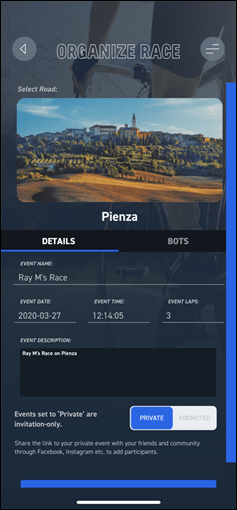
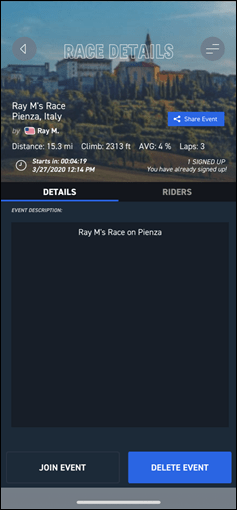
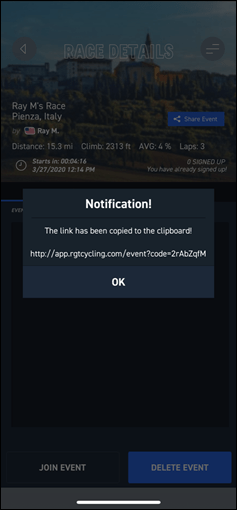
Aside from the clunky two-device requirement, my only issue with RGT is more about people. Or rather, lack thereof. On the smaller crit courses with COVID-19 it's not an issue, because more people are indoors. But when you take a route like the Stelvio and only toss 20-30 people on there, it feels empty. That's because while Zwift effectively locks it down to two live courses per day, RGT allows any course to be selected any time. I've long argued they should reduce that to 2-3 live courses on any given day. For example, they could have one mountain course, one non-mountain course, and one crit course live. That's it. That'll drive more people into those environments which make it feel much more alive.
Finally, RGT has a pile of structured workouts you can execute too, which are done atop a course of your choice:
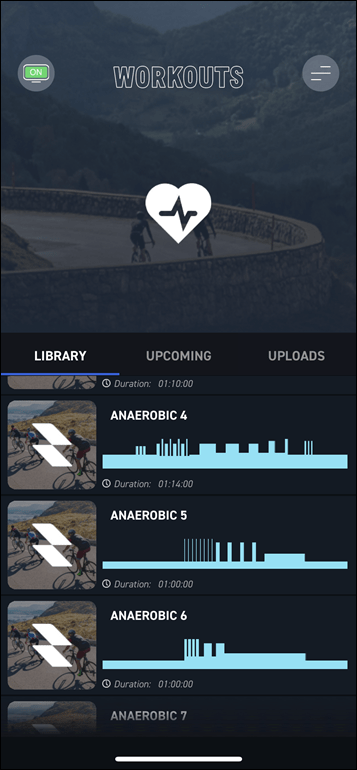

You can even e-mail them structured workouts and it'll end up in your account. This and the e-mail of Magic Roads are a good example of finding balance between offering features and having it be totally automated. RGT doesn't quite have the volume to need to automate the ingest of these functions, so e-mail still works. Whereas someone like Zwift at the scale they have, e-mail doesn't work, and they need to automate more. For now, RGT is perfectly fine using e-mail as a means to enable these bits for people:
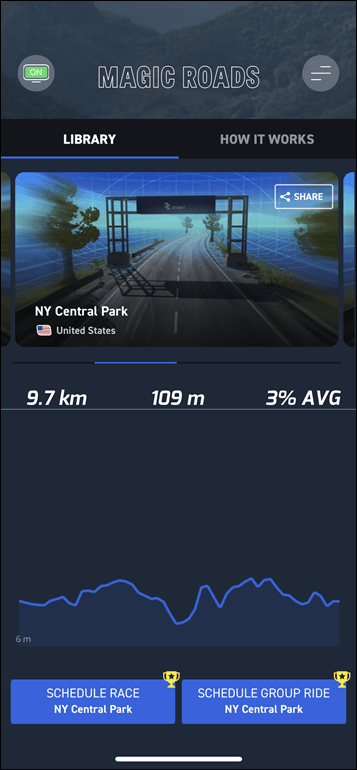
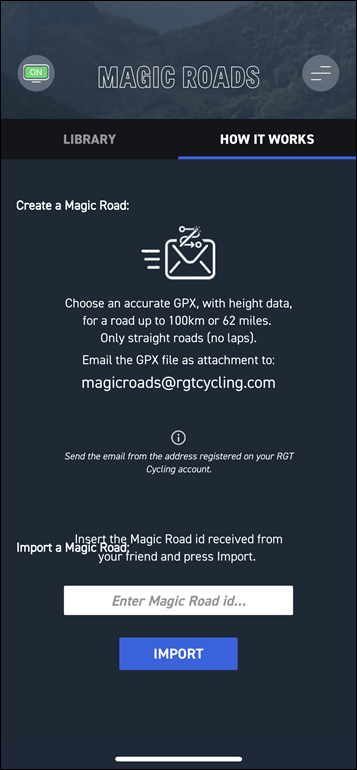
Overall I think RGT is trending in the right direction here. People being locked at home is finally getting real riders onto the platform, which may be the catalyst it needs. As I've said time and time again, I'd really like to see them at least trial the idea of a week or so of reduced course options to see if it increases the social aspects of the game. I know it might make some unhappy, but I think it's what the platform needs to increase overall appeal. Beyond that, I'd really like to see them re-think the whole dual-screen thing, especially when on a tablet.
Still, despite those tweaks, I'm looking forward to whatever RGT focuses on next within the app. I believe they and Bkool are really the closest viable alternatives to Zwift if you're looking for virtual world racing. Bkool undeniably has more people, but I think RGT has a bit more finesse. We'll have to see how it all plays out.
Kinomap:
Kinomap is one of the apps that's been around a long, long time. Longer than most of the apps here in fact. The company largely specializes in videos from both outdoor (real-world) locations as well as indoor classes. They also have structured training as part of that, both with and without videos.
The app allows you to pair to basically any smart fitness device you can imagine. In fact, I'd even guess that no app has as much connectivity in it than Kinomap. The team there is like a Tinder power user for connected fitness equipment, if they can hook-up with it, they will.
To begin, you'll crack open the app and find three core scenarios: Videos, Coaching (also includes videos), and Intervals:
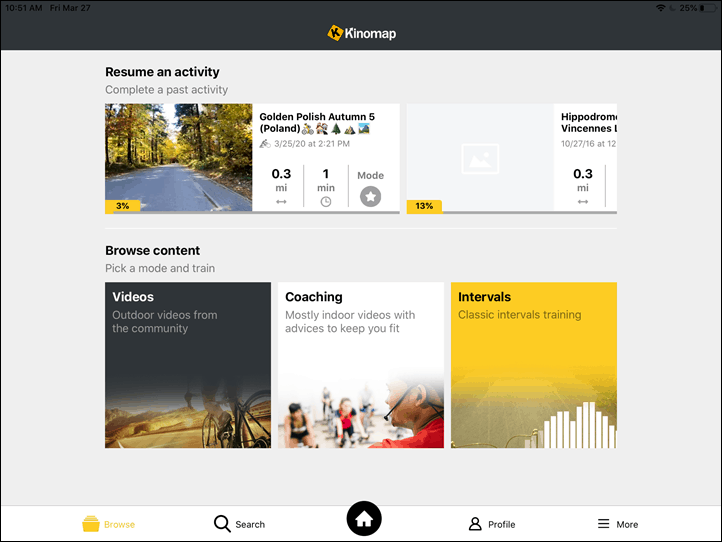
Working backwards, the Intervals section is where you'll find simplified structured training. This isn't as advanced as some apps like TrainerRoad, but certainly has more than enough options in here to keep you busy on occasion:

Next, there's the Coaching section. This is where coaching videos meets intervals. Each one of these are coached workouts that are recorded with video and synchronized to a structured training. Your smart trainer (if you have one), will automatically adjust resistance based on the workout. These vary quite a bit. For example, there's workouts that are a bit more like a Peloton class, while others are from endurance sports coaches. And yet others are ones from groups like GCN :
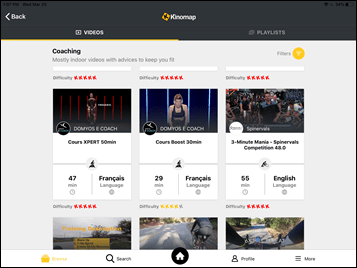

We'll come back to this in a moment.
Next, there's the main videos section. This is where the vast majority of Kinomap's history and library comes from. They've got thousands and thousands of videos from all around the world. Some are super-crazy high-quality gimbal-stabilized videos shot on expensive production cameras. While others are simply from a GoPro on people's bikes. Heck, I've even got a totally random video uploaded to it.
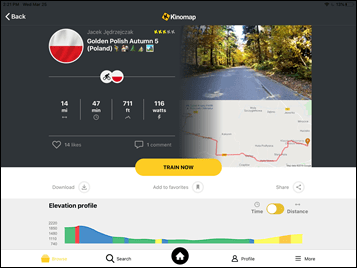
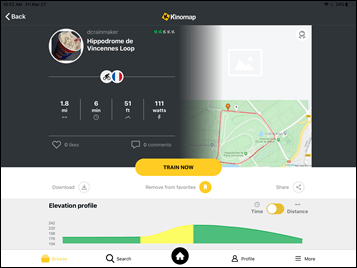
Knowing this, you can sort by quality levels as well as numerous other parameters, including map views and such.
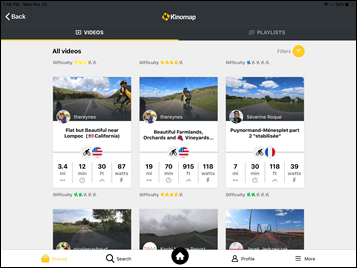
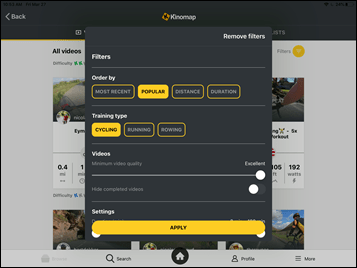
In all of these videos, the terrain will control the resistance on your smart trainer. So if going up a climb, it'll automatically adjust the simulated incline accordingly. They also adjust the video speed to match your output. In most videos this works out, but sometimes a video will be filmed at a substantially faster or slower speed than you're riding it, and things like passing cars will look out of place. It's a similar challenge on other apps that record outdoor rides, like Rouvy.
Now, to combine the best of both the outdoor video and structured training world I've picked this Coached workout from GCN. In this case it's a blend of presenter footage of them riding inside a studio, with outdoor footage from a scenic and stunning European mountain climb. However, despite being a climb, technically speaking the resistance is using ERG mode – and not incline.

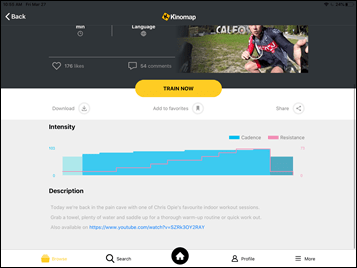
While riding it, I can see other riders that have or are riding it at the moment, plus the resistance target on the right side in that mini-graph. At the bottom I can adjust resistance if things are a bit askew. And that's one of the challenges of the coached workouts here is that you can't see the exact wattage target like you can in most structured workout apps.
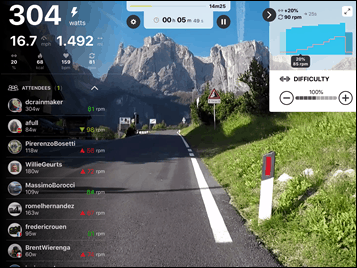
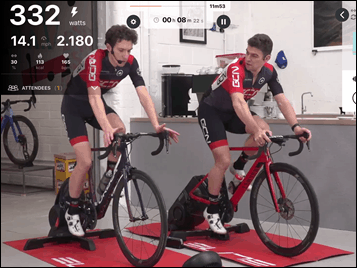
Kinomap says that's done because a core chunk of their market is on indoor gym equipment which might not display that, so this keeps it more general at % based levels (e.g. 30%). It wasn't a huge deal for me in this workout, but still, mentally I'd love to have known what those targets were.
Meanwhile, in the upper left side I see my current stats.
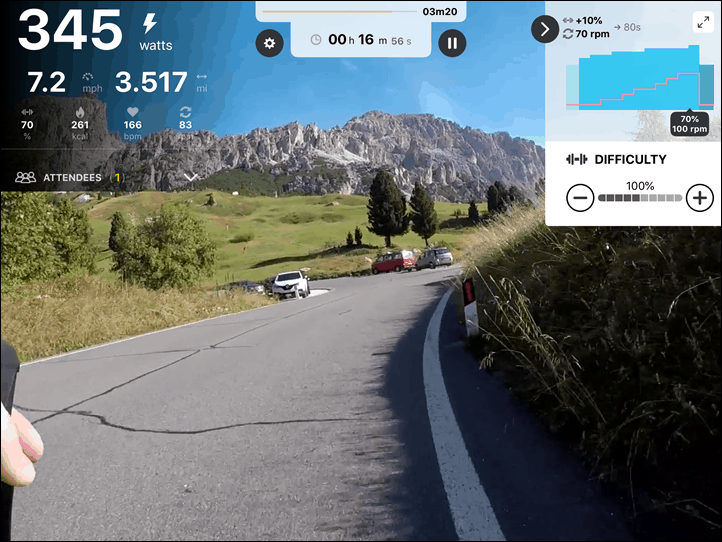
I had connected it up to a smart trainer, as well as a Bluetooth Smart HR strap. Again, basically everything is supported here just fine:

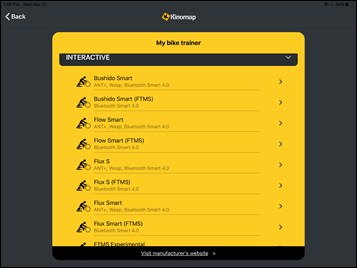
After the workout is complete (and for the record, this workout is a beast despite the duration – it's used more as a warm-up), then you'll see your summary stats:
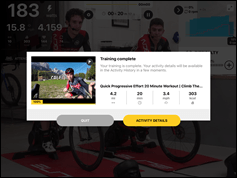

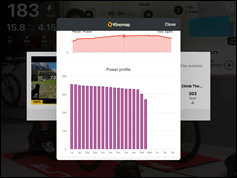
And then from there it'll sync to various training platforms such as Strava & TrainingPeaks.
Kinomap is a solid option for those that want outdoor/real rides from all around the world. The coached workout sessions are also a good way to mix it up if you're primarily a real rides type person, but want a bit of variety to spice it up. Plus, you can even record your own favorite outdoor rides easily and then re-ride them all winter long again. Or, you can just ride epic locales you can't normally access. Now if you're more of an ERG mode type person, I probably wouldn't recommend Kinomap given the lesser amount of indoor training plans and fewer structured workouts. But that's really the only issue I see with it.
Peloton App:
With over 100,000 subscribers to the tablet app alone (not including the bike subscribers), the Peloton app is likely #3 or #4 based on subscribers. Still, like the Peloton Bike, a lot of people that haven't ever used Peloton tend to misunderstand it. Sure, there's plenty of workouts that aren't terribly different than what YMCA's Spin Classes have been doing for years. But there's also boatloads of workouts that are based on wattage & power zones, and led by Olympic cyclists, Tour de France riders, and more. These are legit very structured workouts that rival anything you'll find on any other platform. But more on that in a minute.
Peloton cycling comes in two basic flavors:
A) Buy a Peloton bike for $2,250, then pay $40/month
B) Use your own indoor bike, then pay $12/month for the app
The classes are identical and the same. The only difference is that if you use your own bike, you can't send power metrics to the Peloton app. Only the Peloton bike supports that. You can however pair a heart rate strap/sensor to the Peloton tablet app without issue (any Bluetooth Smart HR device).
While I will be doing a full review on the Peloton bike I bought back in January (review slated for April), this tidbit here is all about the tablet app. The app is available for iOS (iPhone or iPad), Android (phone or tablet), Amazon Fire (TV or tablet), and web. Yes, I said web. You can actually use it entirely online with a simple browser. For the purposes of this though, I'm gonna use an iPad with a regular bike/trainer combo. You don't need a bike trainer though with Peloton, any spin bike or stationary bike will do.
Once logged in you've got a bunch of core categories, including cycling, running, strength, yoga, meditation, stretching, walking, cardio, and bootcamp. Given this whole post is about cycling, we're gonna stick to cycling.
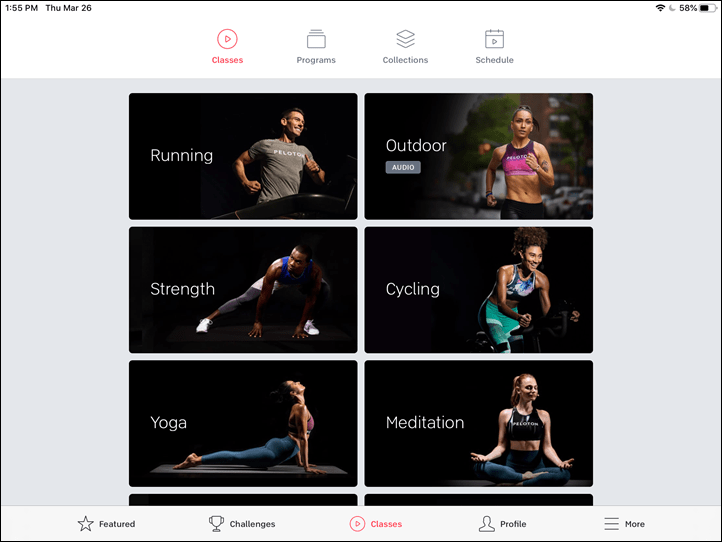
Within that, you'll see a schedule of existing classes. However, you can tap 'Schedule' at the top and see what's coming up that's a live class. Right now because of COVID-19, the studios are all empty save the instructor. Still, digitally there will be thousands on the leaderboards doing the class with you. Point being if you look at classes older than a week ago, then you'll see real-live people in the classes too. You can replay just about any class you want as well later on.
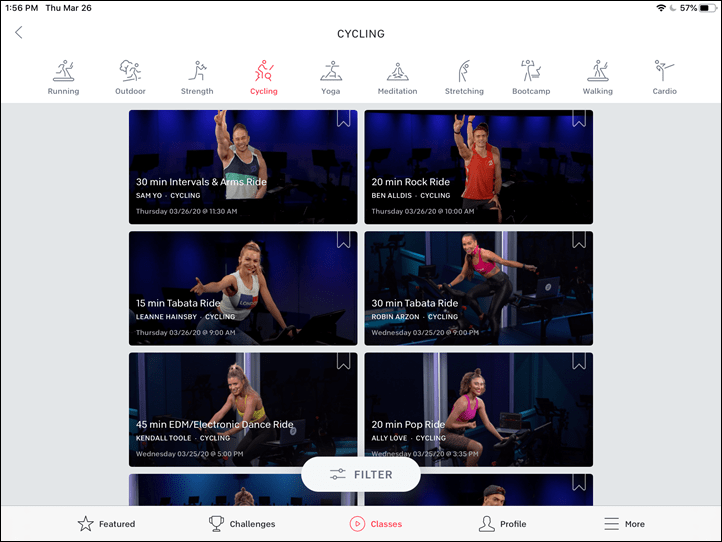
There's also programs and collections. Programs are essentially a collection of workouts arranged by days, for multiple weeks laid out.
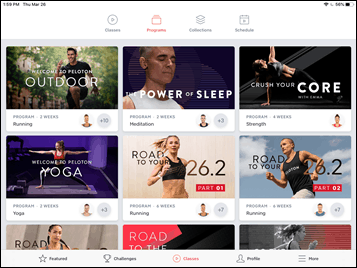
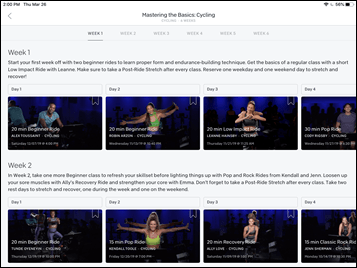
Whereas collections are more like a playlist of classes that are popular or themed in a specific way.
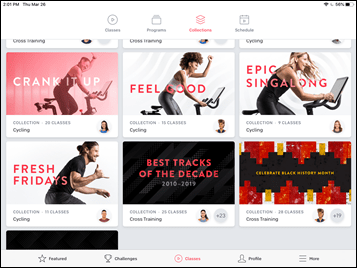
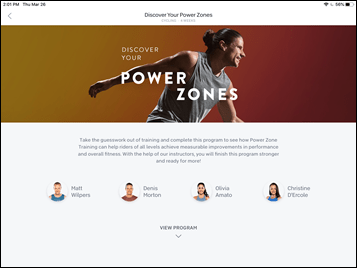
The ones that might appeal most to folks here are the Power Zone workouts. This is available in both an entire four-week program that first aims to establish your FTP and associated power zones, and then from there everything is based on power zones. Now that's a bit tricky if you don't have a power meter at all, and further trickier since the Peloton Digital App doesn't connect to a power meter or smart trainer at all (only the Peloton Bike allows power display). But, if you do have a power meter/trainer and a watch/bike computer, then it's pretty easy to sort out your power zones as you would with any other app here and just stick in those as defined by the workout.
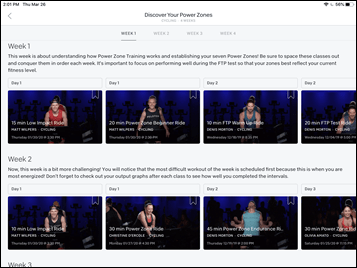

For me, I enjoy Peloton workouts in one of two basic categories:
A) I turn my brain off and just enjoy getting a solid workout with usually well-matched music
B) I do a structured power workout, but still with music
For the second one, my favorite there is doing workouts by former Tour de France pro Christian Vande Velde. He seems to roughly do two workouts a month (far less than most other instructors). They're almost all power-based, and all highly structured. You'd have a very hard time (if at all) telling them apart from anything you might see on TrainerRoad. Specificity is clearly the key here.
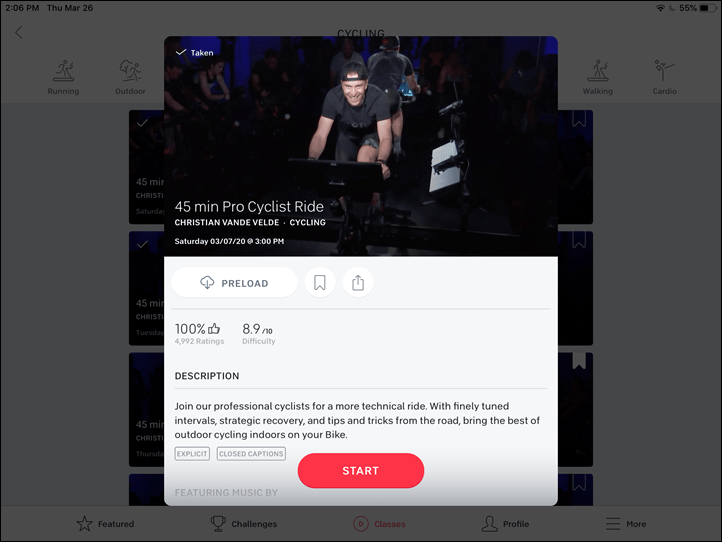
In any case, once you select a workout (from anyone) you'll be able to pre-load it if you want to. Or tag it for later. Pre-loading allows you to then take your tablet/phone/whatever to somewhere that might have sketchy internet, like a hotel or gym. You can also see details about the workout, ratings for it, and the music in it. Music is everything to Peloton. Without music there would be no Peloton.
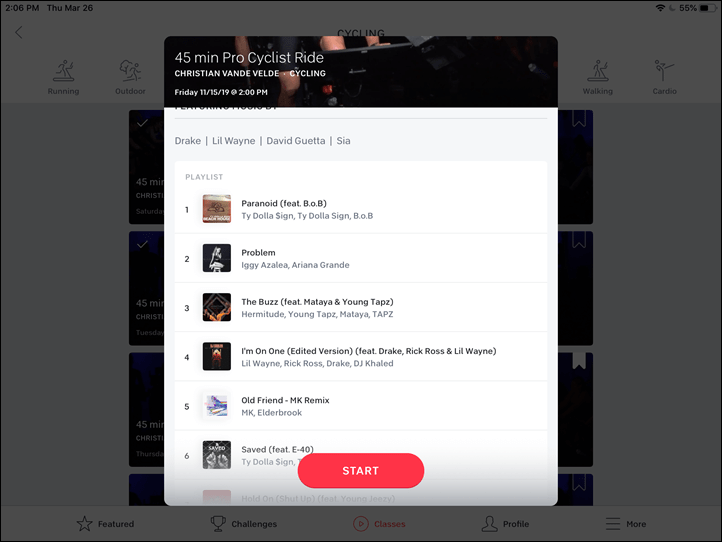
You can also pair a heart rate or cadence sensor too:

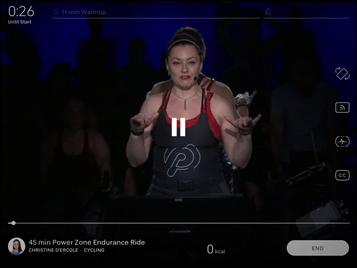
Once in the workout you'll see the leaderboard to the right, as well as any high-fives from others. On the left you've got your heart rate and cadence. Up top is how much class time is remaining and the current chunk of the workout. There's way less information on the Peloton Digital app than on a Peloton Bike:

You can mirror/cast your tablet to a bigger screen using either Airplay or Chromecast
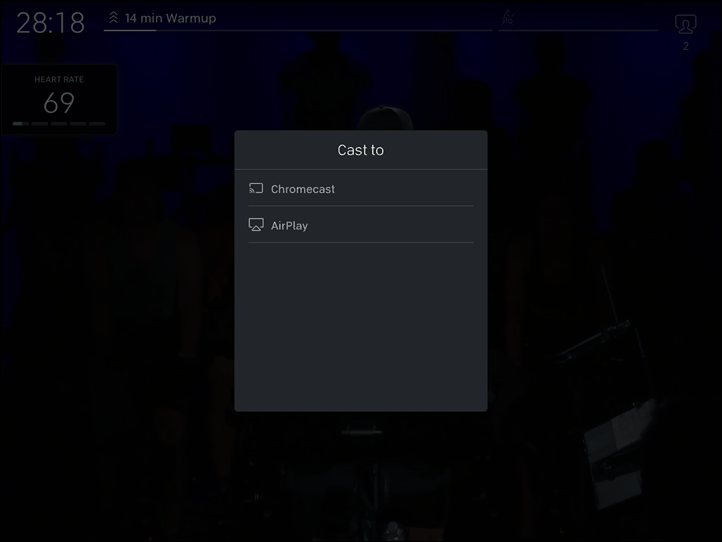
The downside to the Peloton Digital App compared to the bike is the lack of showing the current targets for the workout, as well as some of the leaderboard bits. They just aren't anywhere near as useful as when on a bike. It's probably one of those things you don't notice until you have the bike and try to go back to the Peloton app, but still. For example, here's what you see on a bike:
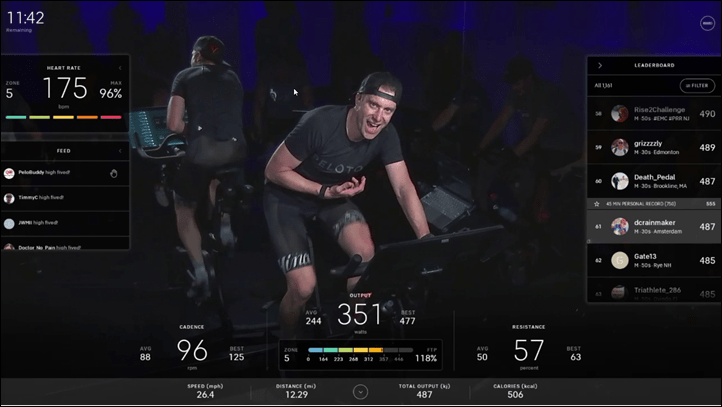
Once you're done with a workout you'll get the summary stats within the Peloton app. You can sync it to Strava, however that requires being done once on a real Peloton bike. Any Peloton bike. Even your friend's, one at a hotel, or a Peloton studio. It's frankly a stupid and annoying restriction for a platform you pay Peloton to use.
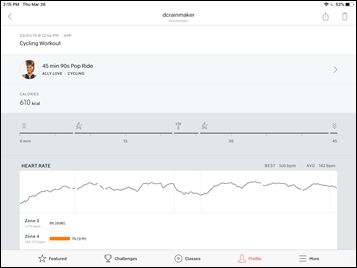

The Peloton app is undoubtedly different than every other app on this list. However, it's also something that I suspect most cyclists here would actually find pretty engaging once you get into it, especially the power zone workouts. There are undoubtedly elements of some Peloton classes or specific instructors that I just find too over the top, or just too much 'inspiration in a bottle' type messaging for my tastes. But the majority of them I do enjoy quite a bit, and the workouts go by exceptionally fast in comparison to most other platforms. Given their current 90-day free trial program, it's probably worth even just to mix things up from time to time.
Rouvy:
Rouvy has a blend of a number of different aspects in the platform. They've got thousands of outdoor videos, from locations all around the world. Then there's structured workouts (which can be done atop certain videos), then there's augmented routes, which are normal outdoor videos that have 3D elements overlaid on them like riders or sprint/finishing banners. Rouvy can sync in structured workouts from TrainingPeaks as well, plus you can create your own video and non-video routes and ride them too.
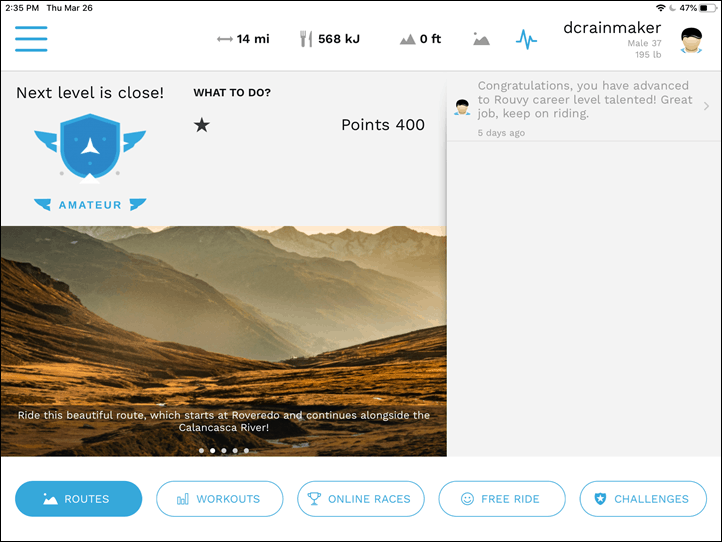
Starting with their core offering, Routes, you've got a pile of categories of different routes to pick from. You can filter these numerous ways, including on a map by just zooming around:

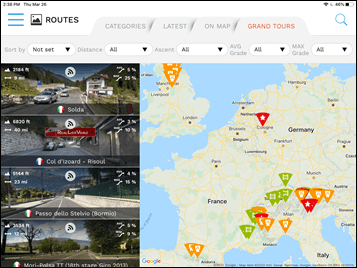
As you select a route it'll show you the stats for that route and a map too:
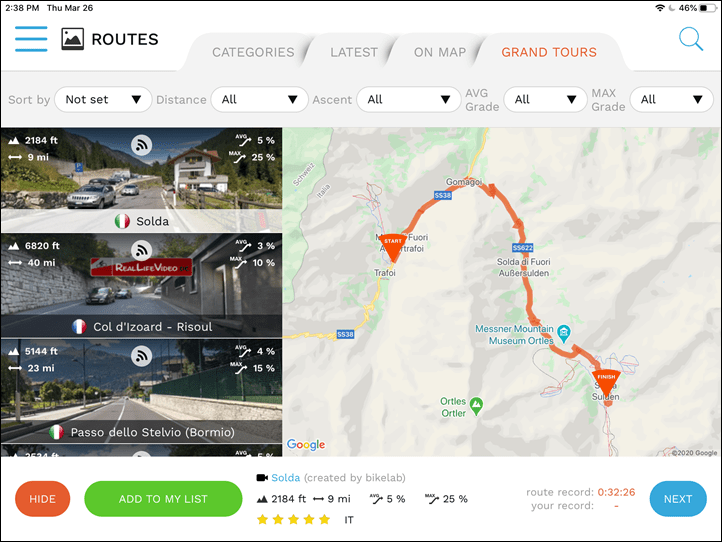
At that point you can tap next to pair up any trainers or sensors that you might have. You can save multiple sensors here. You can also add a virtual partner, which is where you might add a friend that recently did the ride and try and beat them.
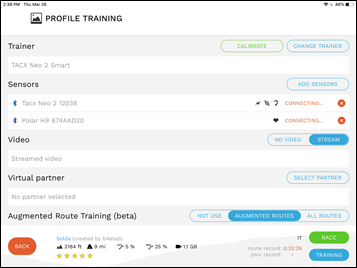
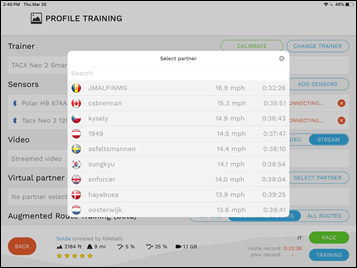
Below that is the option for augmented routes. I've written about that fairly extensively in the past here. But as noted above it allows them to generate 3D riders and course elements atop and into the video itself to try and make it look like you're racing or training with others that weren't there when the video was shot. In some cases it looks fantastically realistic, and in other cases it's a bit fake looking. Seems to vary.
For example, below the rider to the right is simulated, whereas the riders to the left are real. At a quick glance, you probably didn't realize that.

Once you're ready you'll hit training or race to begin. However, in my case I'm going to back-up slightly and choose a structured workout instead. Within that, I went into the popular category and selected one of the handful of structured workouts with a video overlay on it.

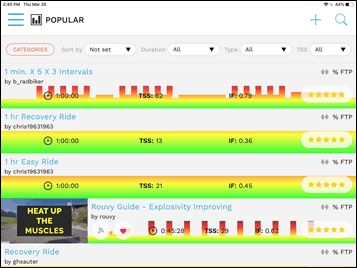
Like before it'll ask you to validate trainer pairings and such, and then into the workout you go. It's here you can choose what you want to see. For example, perhaps you want to see the structured workout bits:
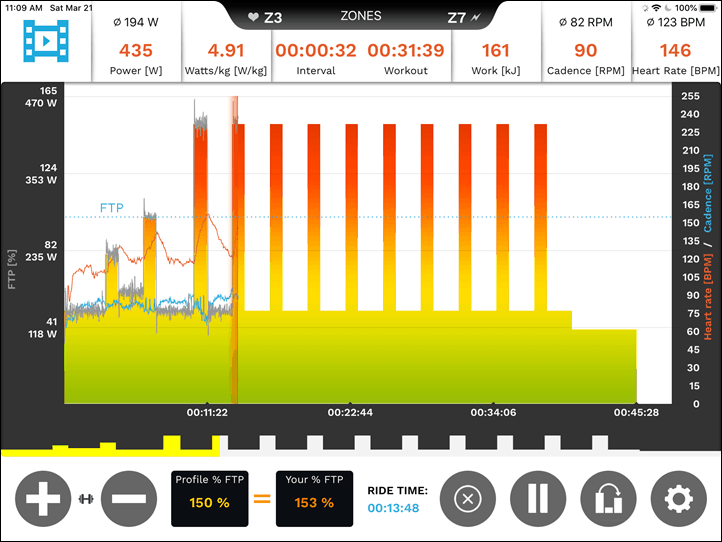
Or, perhaps you'd rather just see the road ahead:
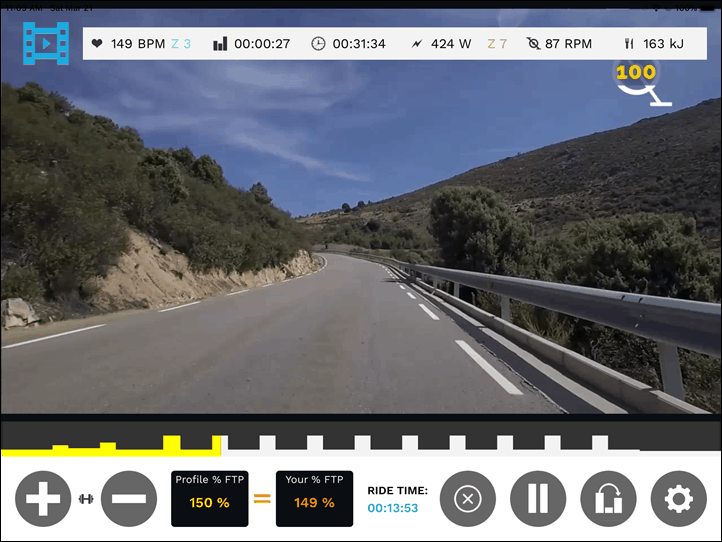
In that case you'll see the workout pieces shown down along the bottom. And then as each interval or section starts it'll have these gigantic screen overlays, just in case you had placed your tablet on the other side of the room.
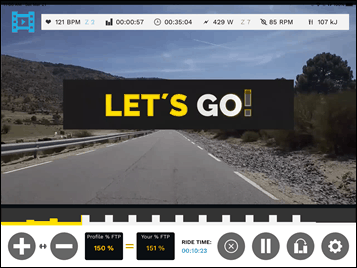
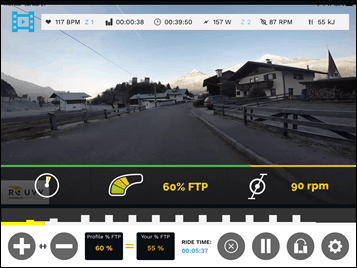
The whole piece worked great, plus, there was music timed to it as well for the entire workout. Of course, my headphones died half-way through. But can't exactly blame Rouvy for that. Afterwards you'll get your summary stats like most apps:
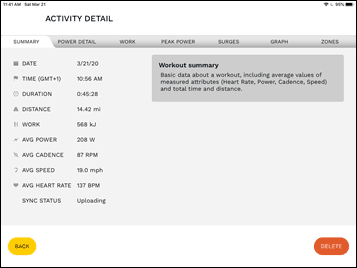
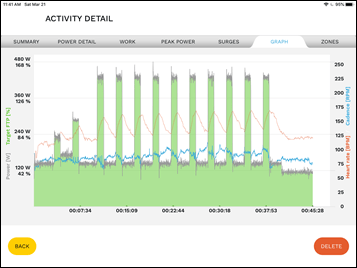
And then as usual that'll sync off to various 3rd party platforms automatically.
I see Rouvy and Kinomap as pretty similar in a lot of ways. From the types of content, to their user interfaces, to even their color schemes. Each though has its own take on it. In the case of Rouvy, they've spent a lot of time on their augmented reality bits, with the overlays and all. The idea being to still allow Zwift-like races, but on actual real-course videos. And by and large it does work pretty darn well. Whereas Kinomap has their twist being more around coaching and coached videos, which they've expanded quite significantly in the last year.
So you've essentially got to decide which type of secondary content works best for you. Both companies have tremendously huge libraries of real-world course videos, and both companies have ways to skew it slightly beyond that centerline. And both companies spend tremendous amounts of time ensuring that the tech side of the equation (pairing with trainers/etc) is nailed. Trainer manufacturers often note how on-top of things the engineers from both companies are in that respect.
Thus, give either one a shot to see if it's the outdoor platform you were looking for.
The Sufferfest:
In many ways, The Sufferfest is the oldest indoor training platform on this list. Albeit, not quite in the same format that it started. Back a decade or so ago you probably remember going to your local bike shop and picking up Sufferfest DVDs that you'd ride along to. Well, that's the same company as today, albeit with a radically different product. True, the company was somewhat late to pivot, but that's all old news these days – and their app is one of the cleanest and most well-executed user interfaces out there now.
The Sufferfest aims to deliver structured workouts (mostly high-intensity ones, as the name implies), coordinated with videos from epic locales or events around the world. The workout intensity, video, music, and other elements tie it all together into a cohesive package that's crazy immersive. Not to mention the automatic control of your smart trainer to force that suffering down upon you. While Wahoo Fitness bought the company about a year ago, their apps work using the regular industry standards on ANT+ & Bluetooth Smart, so any trainer will do just fine.
The company also has training plans as part of the app, as well as videos and workouts beyond just cycling. These include yoga workouts, strength training, and a handful of running ones. And even mental focused exercises.
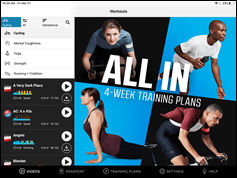

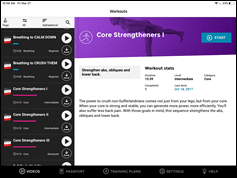
To get started you'll download their app. It's available on iOS, Windows, and Mac…but not Android – a rare omission on this list. In my case, I'm using their iOS app on an iPad. First up, you'll pick out the workout of choice. You can do some filtering on the left side, including time/alphabetical/intensity.

After that, you'll get your trainer and sensors all paired up. The iOS app, for example, can connect to Bluetooth Smart sensors using all the normal standards, while the Windows & Mac versions can also connect to ANT+ sensors.
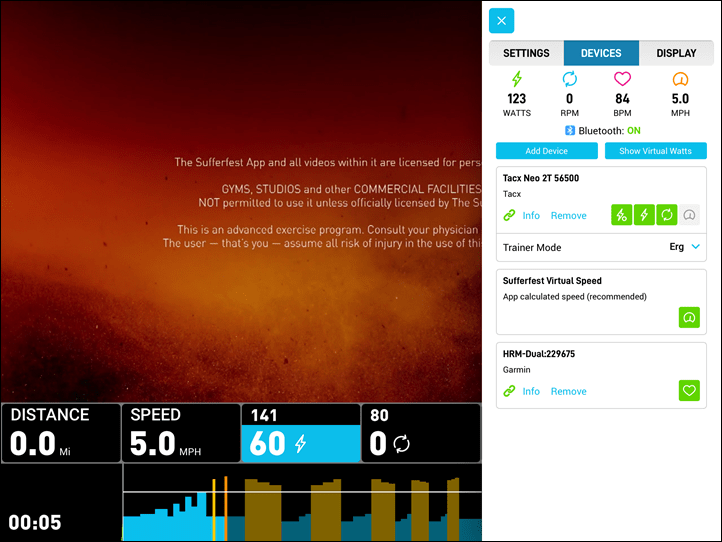
Along the same sidebar where you pair sensors is where you can tweak various settings, including display overlays and such.
After that, it's time to get busy. Think of Sufferfest workouts as coached workouts, with some of the instruction coming on-screen and some coming audibly. Generally speaking, as long as you're following the on-screen bits you're good.
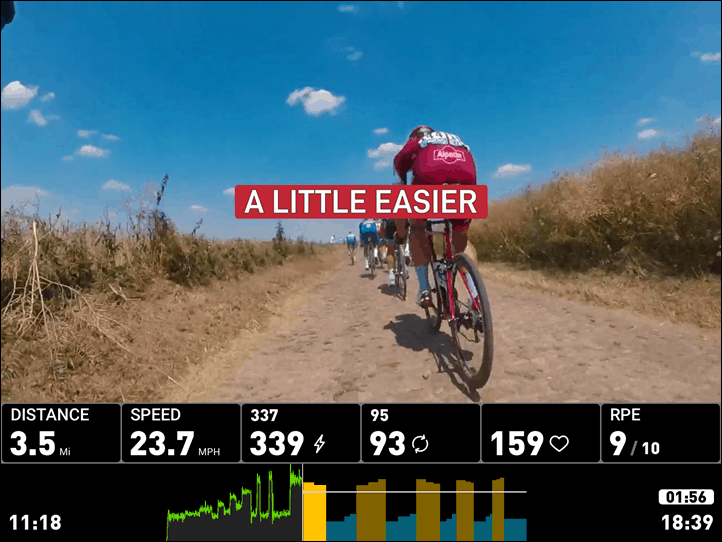
The audio usually adds a secondary layer of detail, but isn't required. SufferFest workouts tend to revolve around either races, group rides, or riding in scenic locales. Two of my favorites are newer ones actually, using on-board cameras from major pro races. One such workout is Team Scream, which is the *entire* time trial from the Hammer Series. It's awesome. Zero video cuts, just one straight shot from the onboard cameras. You're rotating through the team as if you were one of the riders.

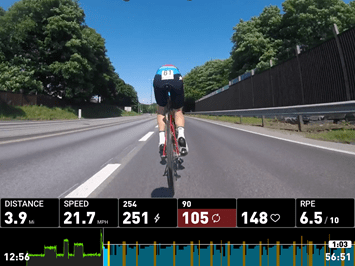
Another shorter version is Joyride, where you're doing some of the stages from the Tour de France, with various intervals accented by cobbled sections. The audio overlay tells a usually fictional and comic story about what's going on.
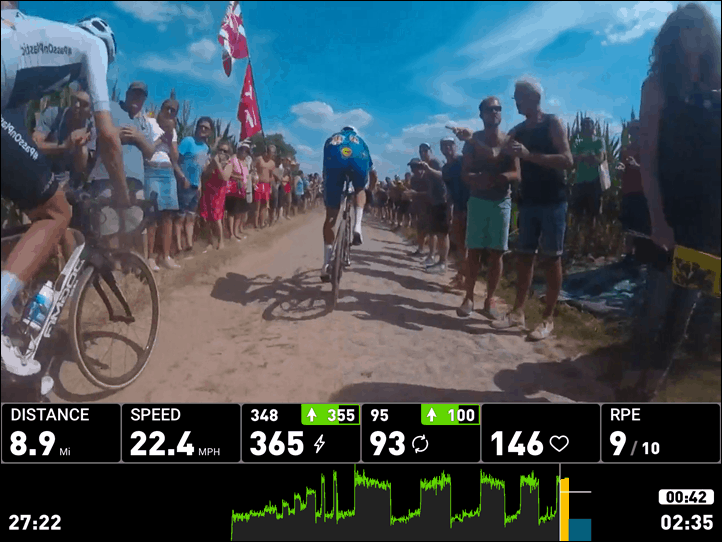
Along the bottom of the panel you'll see the exact target wattages or cadence levels being prescribed as part of the workout. If you have a smart trainer, these will automatically change the resistance on the trainer.
These target levels are based on your '4DP' profile, which is essentially a more complex way of representing your maximal power at differing levels. Most apps use a singluar value, FTP, which is the maximum power you can sustain for an hour. With 4DP, they've got four different maximal power levels that they utilize, which acknowledges that people have different riding phenotypes. Meaning, some people are sprinters, some are endurance, and so on. You can take a 4DP test, which mostly involves being miserable for about an hour. It's got the same amount of suck as an FTP test or other type of athletic prowess test. These four values (NM/AC/MAP/FTP) are listed below to the right, and can be adjusted on a per workout basis (as the app will do in some plans).
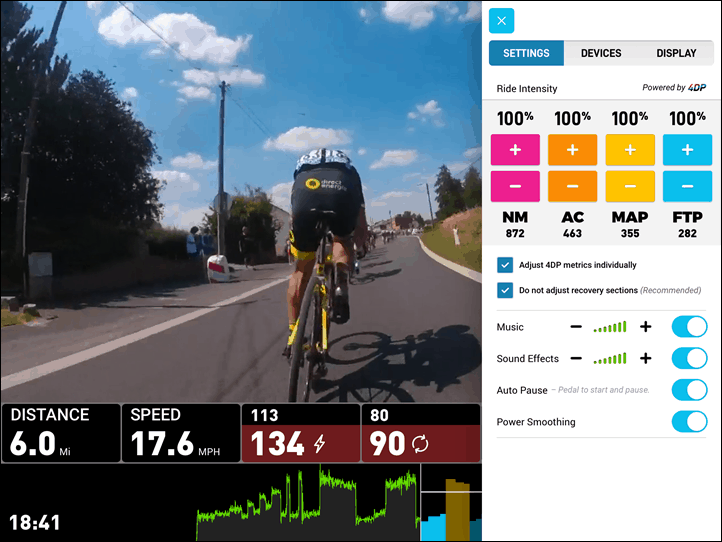
Once the workout is completed you'll get summary stats, and then it'll sync all this data off to the various 3rd party sites that you've configured.
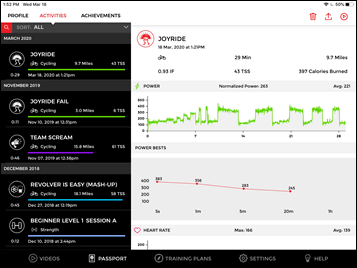
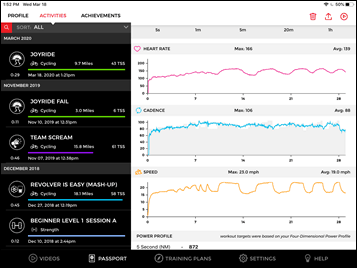
The Sufferfest is a great app for when you want to simply be distracted and can throw down the wattage. It's really really really good at motivating you to ride hard, and keep it up till the end of the session. It tosses just the right amount of snark and insult in your direction to make you want to fight back. While the company does have training plans, the one slight gap in their lineup is individual workouts that aren't 'Suffering'. Meaning, the vast majority of workouts are 'go hard', with very few focused on recovery rides. And those that are, are hard to find.
Still, the variety and production quality of content in terms of video and audio is awesome. And the extension into strength training, yoga, and other aspects does round out the platform well beyond most (all?) other companies' offerings.
Tacx Training App:
The Tacx Training Suite has undergone many iterations over the years, and is among the oldest training apps here – if not perhaps the oldest actual software ones (The Sufferfest might predate it as a company, but Tacx may have had software first). In any event, things are different now, and the days of TTS4 are gone. Now it's just the 'Tacx Training App'. The app features super-high quality recorded outdoor rides, GPS rides with 3D rendering (including the ability to re-ride your own courses/routes), and a smattering of structured workouts.
[Note: The Tacx Training App only connects to Tacx trainers when on iOS or Android, however, on Windows/Mac it can connect to 3rd party power meters. More on that later.]
When you first launch the app you'll see the latest new movies up top. Behind the scenes Tacx works with a company to have these shot on some crazy high cinema-quality production rigs that are fully stabilized. They've clearly been color corrected and everything else you'd expect, plus are almost always shot on a beautifully sunny day. They look fantastic. What you see on this top line is just the latest additions.
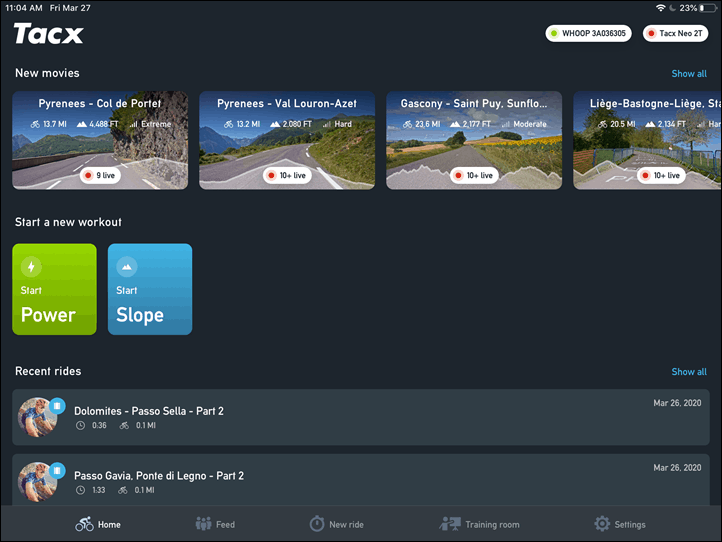
Down below that you can start a power or slope workout, which are just generic templates to record a ride. Where you actually want to go is the 'New Ride' tab, which should honestly be the home tab. Up top there's the Movies/GPS/Workout sub-sections. For movies, you'll see more glorious screenshots to sift through.
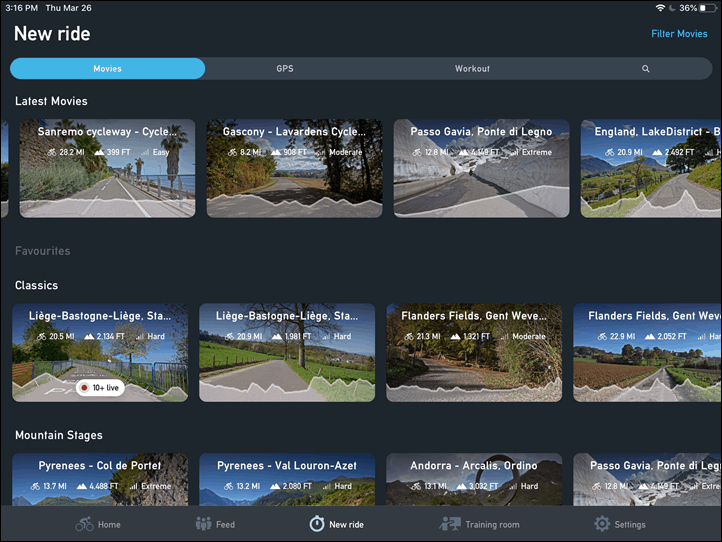
Whereas the GPS tab has a few routes that you, in theory, can ride. In my case, this didn't work at all and just hung forever, so, we'll have to save this portion for a rainy day.
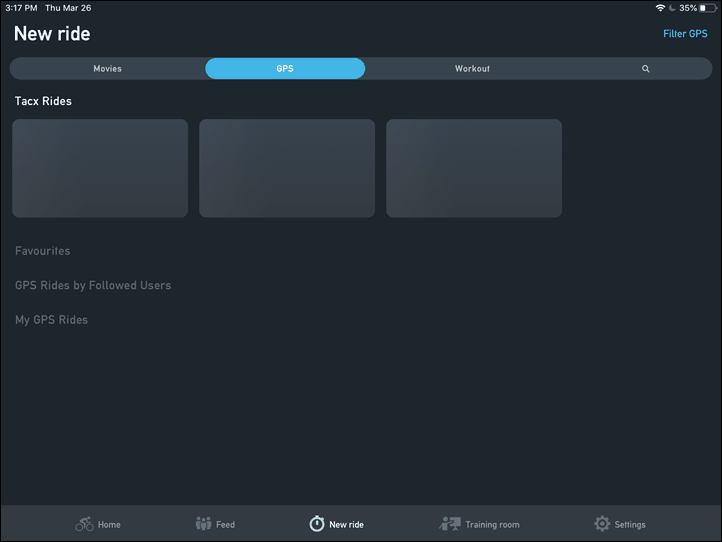
Update: Ok, I tried the desktop version, and this time it worked. Basically it uses Google Earth-like imagery to show your dot moving along. This is handy if they don't have the precise video course you want, you can still see what's around you and feel the elevation changes. Good for pre-riding a course.
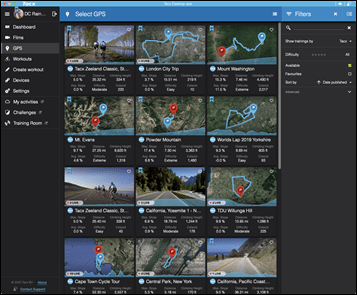
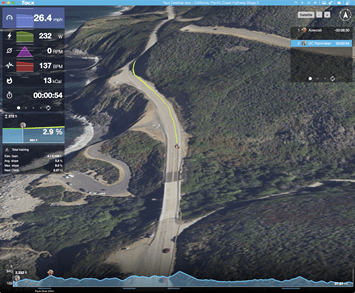
Finally there's the Workout tab, which shows structured workouts. I'd say most of these are pretty basic in composition and utility.
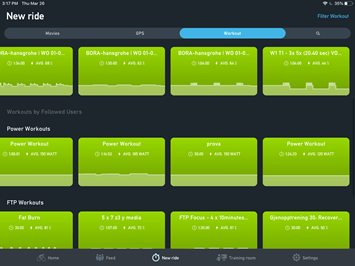
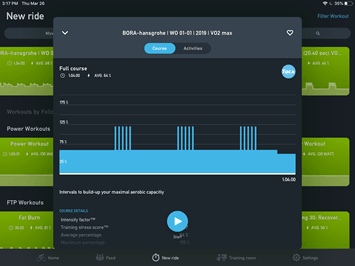
But fear not, there's also the 'Training Room' section of the app. That has challenges, where you can ride a collection of routes over a set number of days and even get real-life water bottles sent to you:
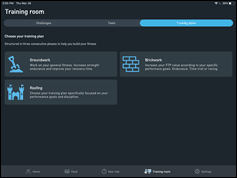
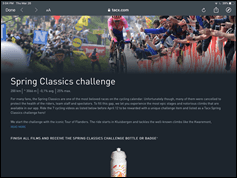
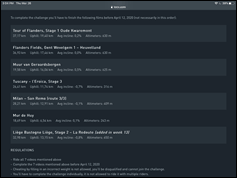
The only downside here is that the app keeps pushing you off to a website, I really wish it were all within the app nice and clean. But dang, the bottles look sweet!
The tests section includes a simple ramp and FTP test that you can do:
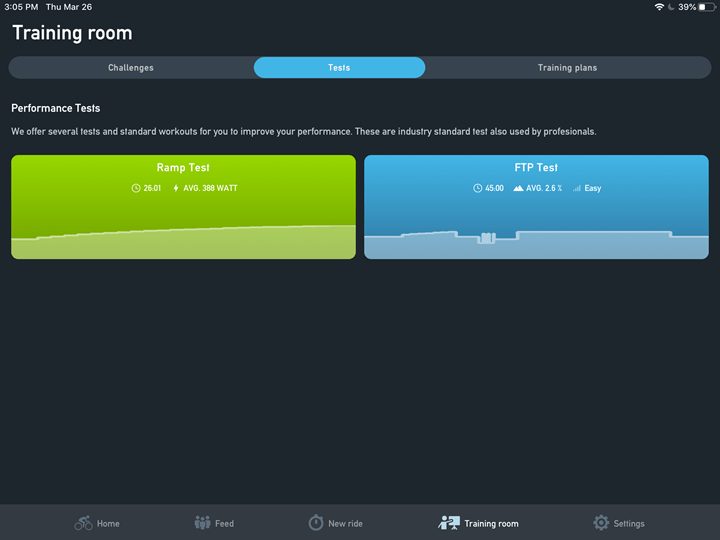
Whereas the Training Plans section has a handful of different plans depending on the type of focus you want (endurance, time trial, racing):
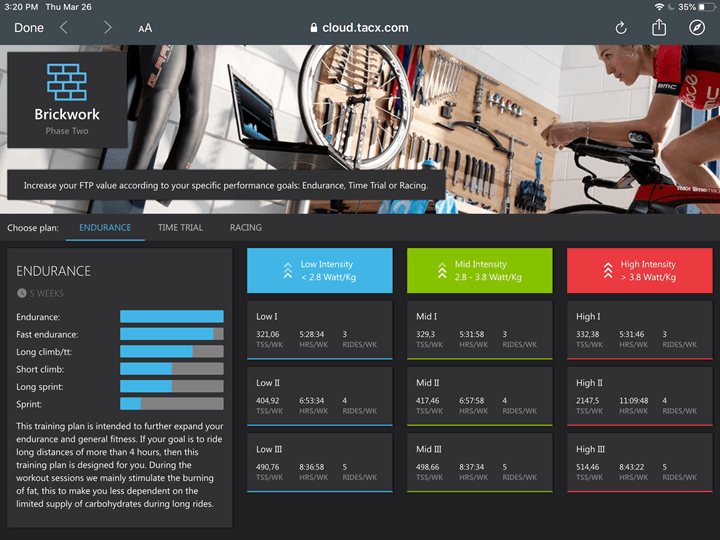
But we're going to head back and ride one of the video rides instead right now, since that's a core area of the Tacx Training App:
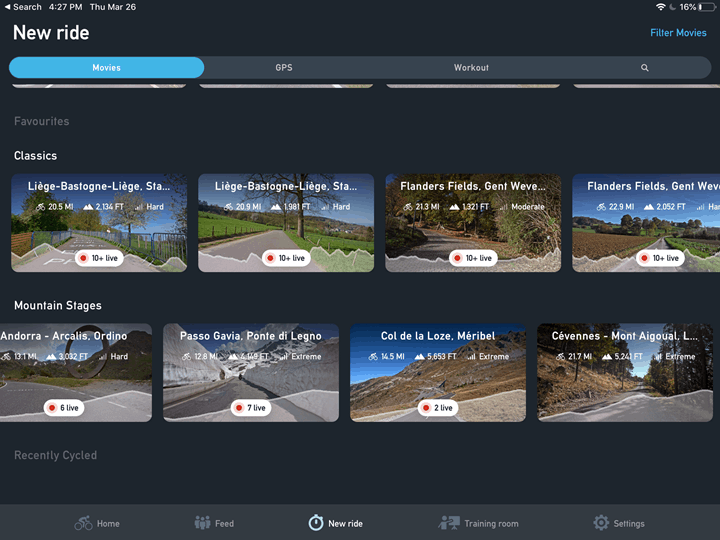
Once I pick a video, then it'll allow me to choose my starting point. This is frankly one of the coolest features I've seen in a video-like program, because a lot of times on the bigger climb videos, the lower portion of the video may start off somewhere in a nearby town in the valley. Fine in real-life, boring to me if I've only got 45 mins. I want the epic views of up high (and the pain that comes with it).
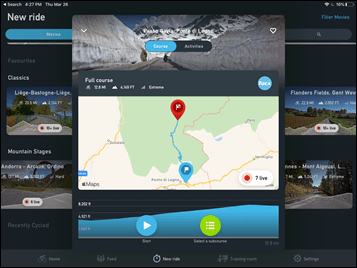
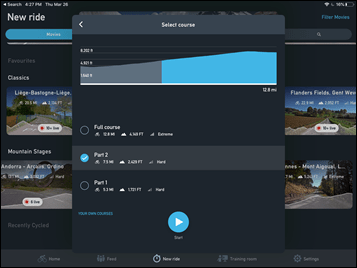
Then, it's off to start the app. You can pair it to any Tacx trainer, though, it won't find other brands (at least via Bluetooth Smart anyway). I tried to find a Wahoo KICKR, no luck. It's an odd omission since back in the Tacx Desktop App days, they did work with other brands. And I certainly don't see any scenario here where someone goes out and buys a Tacx product over a Wahoo product purely for this app. So you might as well take the revenue from anyone as opposed to just Tacx users.
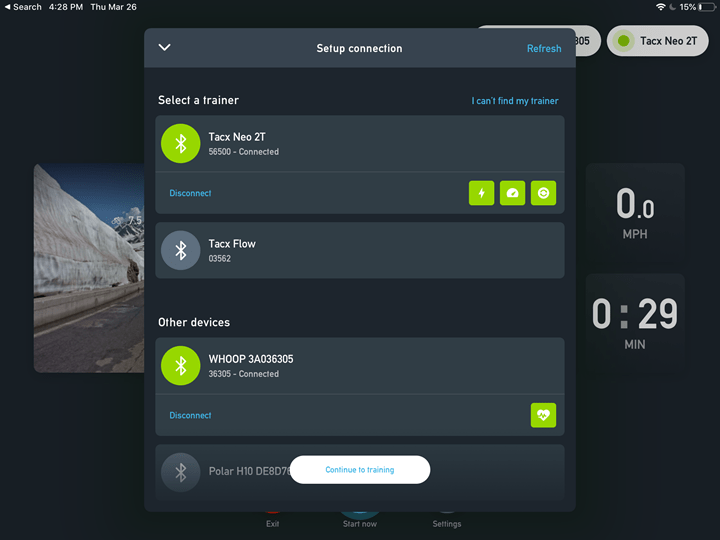
Now, this is where disappointment begins. Despite being the one app that spends the most money to shoot epic videos, and the one app that has those videos stunningly color graded with perfect shadows and highlights…they force you to 720p streaming. Yes, 720p. Oh, well, I mean sure – there's an option for 480p in case you really want that kind of pain:
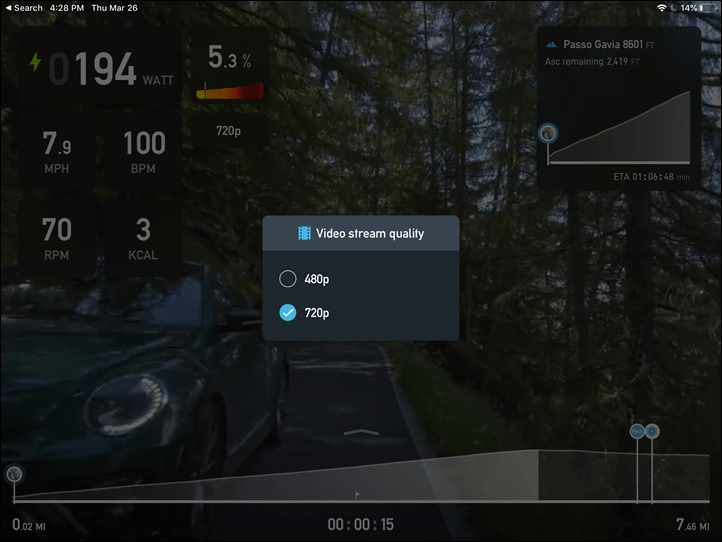
And yes, in theory on the desktop app (I tried Mac), you can get yourself 1080p videos to pre-download. Except, that didn't work. It wouldn't let me select it for any of the pile I tried.
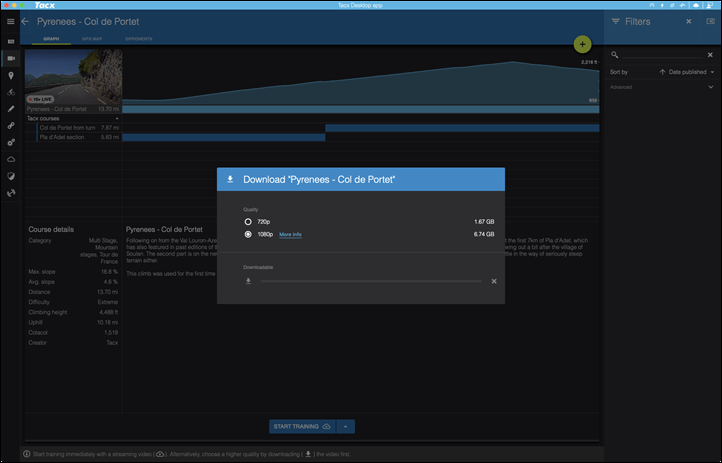
I don't get it. Why go to all the effort to create stunning imagery, stunning dashboards, and stunning videos: Only to offer them in 1998 resolution? I know – I'm probably more annoyed on this subject than any other app in this guide, but c'mon.
Update: Ah-hah, there's actually a higher paid level that shows 1080p videos if you've got a premium account. Except, at the time of writing there's no way to know that level even existed unless you found it within the app where it specifies the 1080p bit. Outside the app on the support site it just says "Premium Videos". Versus inside the app in the support menu you'll find it listing 1080p:
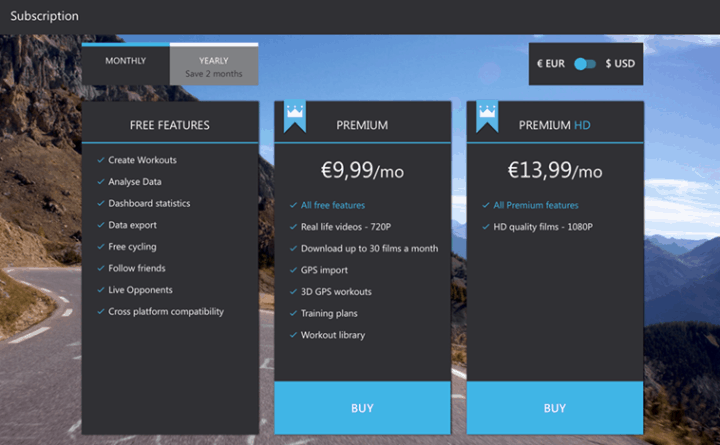
In any case, beyond that, the app works just fine. You ride and it moves the video along perfectly:
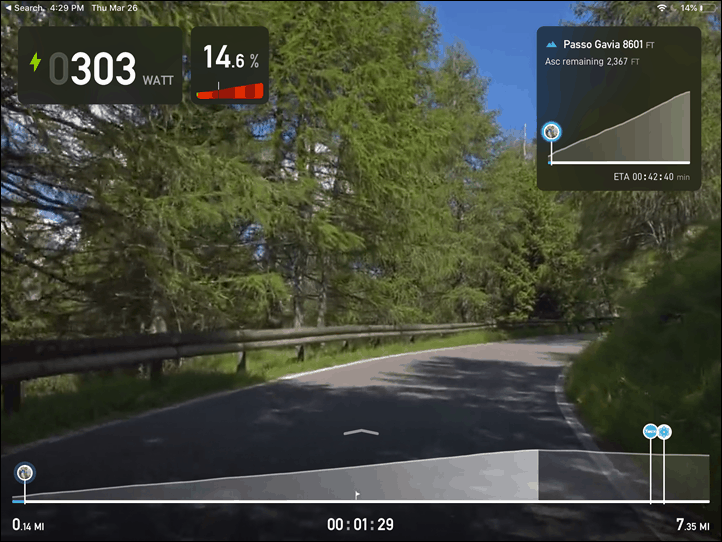
You've got all the stats you'd expect on the screen in various positions. And you can see below other riders on this course as well.
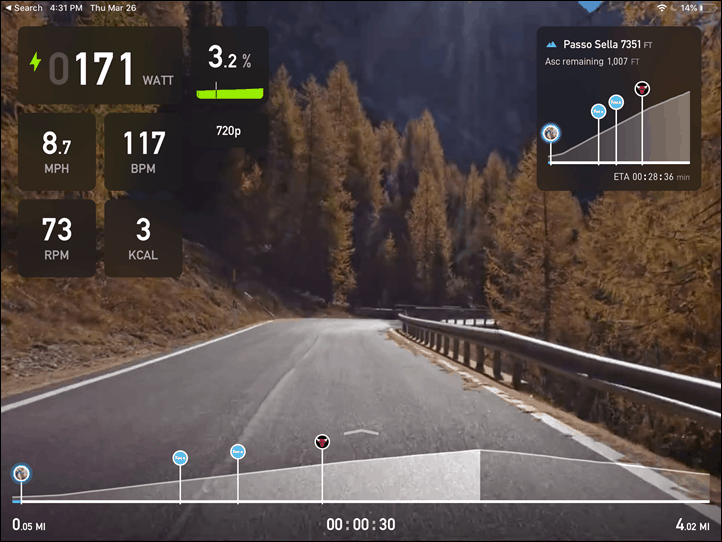
Now the only other downside here is that they only support Strava for post-workout exports. Not even TrainingPeaks. You can at least e-mail yourself a .TCX file, so it's not like you're locked in. But with being over a year now since the Garmin acquisition, I'd have expected you to at least also be able to sync/push a file to Garmin Connect. I mean, even Zwift, TrainerRoad, and others have that.
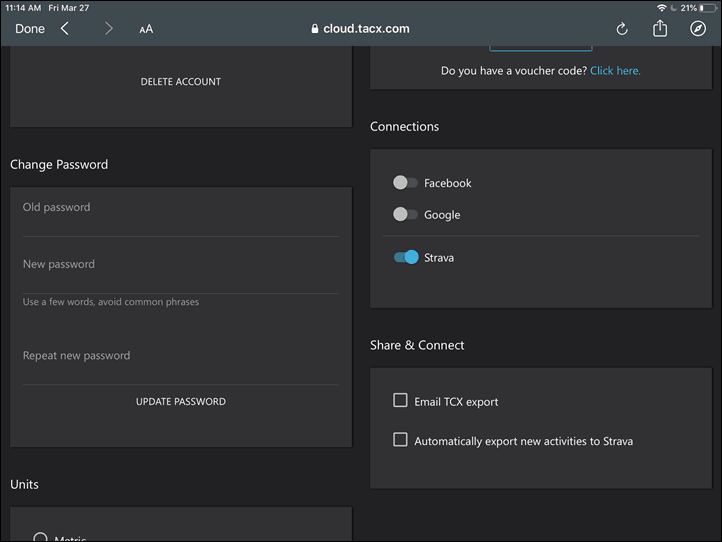
Look – I think the Tacx app is one of the more well-done user interfaces of the entire list I've selected here, at least when you're in the app. But it also feels a bit unfinished. Many options (like settings above), pop you out to webpages to configure. And the same is true for challenges and other features within the Training Room section. And then there's that whole low-res streaming thing or the fact that the 3D bits didn't work for me.
Luckily for you those are all easy things for them to address and fix, and also, it's free to use right now within a 30-day trial. So you can see if you like it, and if so, then perhaps give that feedback back to Garmin/Tacx on the things that you do and don't like. For example – as I said above, I really love the ability to be able to start at predefined segments/chunks within the route. That's super cool. As is the underlying quality of the videos here – nothing matches them in terms of how they were shot and processed. It's just that I really want to see that. Especially those of us with big-screen TV's. I'd love to be able to have a Tacx Training App on Apple TV with a 4K option to stream those movies back (just as YouTube, Netflix, and even FulGaz do). And I WOULD pay the extra few bucks for 4K (but I don't feel like I should have to pay it for 1080p). In the meantime though, I'll contemplate chasing after one of those swanky free water bottles as part of one of the challenges they have.
TrainerRoad
TrainerRoad sits comfortably as the second biggest cycling app behind Zwift, though, it's actually older than Zwift. At its core ERG functionality, the app hasn't changed dramatically over the years. Instead, the company has increased the number of ancillary features (as well as a whole bunch of polish), offering things like outdoor structured workouts and training log functionality. Ultimately, TrainerRoad though is all about executing structured training via specific workouts and heavily curated training plans. They then round that out with everything from season/race build planning, to their enormously popular 'Ask a Cycling Coach' podcast, and their always packed forum. While Zwift has ardent fans, I'd argue that TrainerRoad has a bit more cult-like followers (in a good way). Most people that stick with TrainerRoad for a bit, tend to stay there for years. Some do have dual accounts with Zwift however (like myself).
TrainerRoad is available on all major platforms (albeit not Apple TV), and the low graphical requirements make it easy to repurpose an older computer or tablet for the task at hand. Like Zwift, if your trainer (smart or dumb) doesn't connect to TrainerRoad, then realistically you probably don't want to be riding it. The company has an entire dedicated lab to working through trainer compatibility with companies.
When you launch TrainerRoad you're essentially looking at either doing one-off individual workouts from their sprawling library, or, doing a specific training plan. The company includes all training plans in their offerings, and there are three core types of plans: Base, Build, and Specialty. Each of these three categories then has numerous secondary options with different block lengths. For example ones for cycling versus triathlon, or low volume vs mid or high volume:

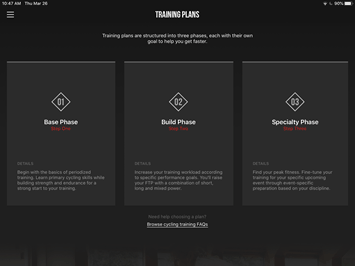
Once you choose a plan, it'll then show those workouts for you. Again, you don't need to choose a plan. For the vast majority of the 8+ years I've been using TrainerRoad, I've just done ad-hoc workouts. But, if you do choose a plan it'll start off with a ramp workout to assess fitness, and then go from there:
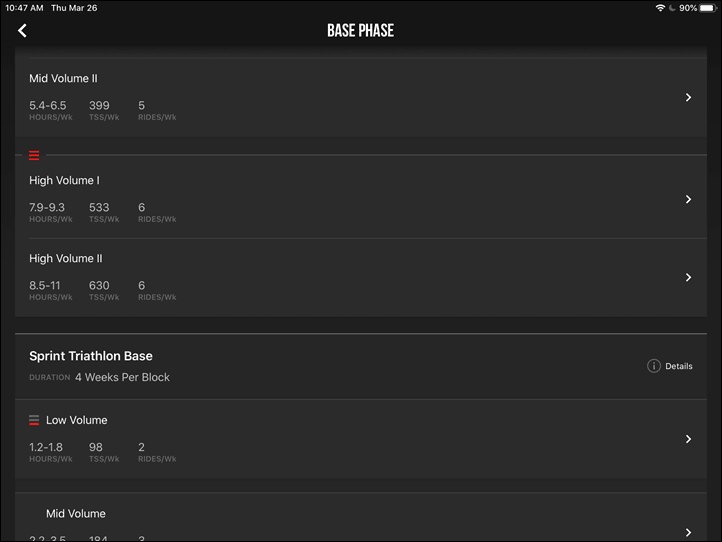
At that point, plan or not, the experience is the same. Once you crack open a workout you'll see the workout structure, as well as descriptive notes. It's this piece that probably sets TrainerRoad apart from most of their competitors. The workouts here all have a very specific purpose. Now, from a coaching theory standpoint one might or might not agree with every workout they've designed, but at least they explain their line of thinking and why they're doing what they're doing. Also, on the right side you'll see 'Workout variants', which can add/remove time or intensity.
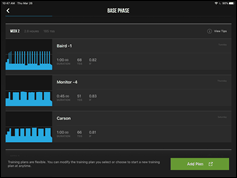

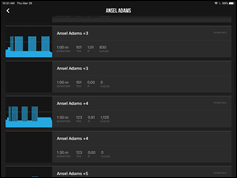
Up above you'll see the workout wattage and structure of course, which are based atop your FTP. Change your FTP, and the workout pain increases or decreases. At this point you'll tap 'Load workout', and you're ready to begin. If you haven't paired your trainer or sensors yet, you'll do that through the sensors menu. It's quick and easy and they support tons of smart and non-smart trainers:
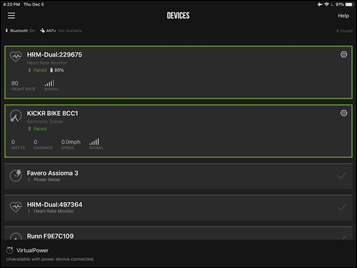
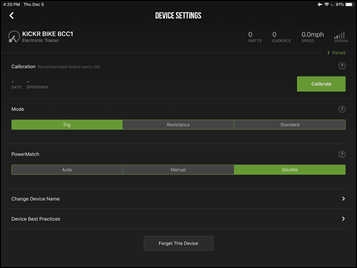
Within those menus you can calibrate as well as enable features like PowerMatch, which matches your trainer to your bike's power meter, so that the wattages will match out on the road. That feature can sometimes be a bit finicky in certain combinations – so I wouldn't recommend using that on the regular, unless you've got a specific significant trainer inaccuracy issue you're trying to fix.
Back in the workout, I'll tap start to begin and then I'm off. The app will show your stats, including target wattages, and automatically change the resistance of your smart trainer accordingly. If you need to increase or decrease how hard the workout is, you can do so via the intensity (such as if you're not feeling good, or if perhaps it's too easy).
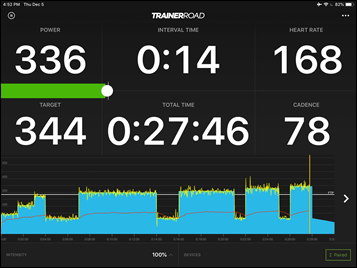
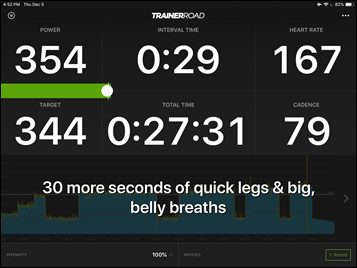
Some workouts have specific instructional text in them with things you're supposed to work on. While others are silent. In some ways, this all looks simple. And honestly, it kinda is. But that's also kinda what makes it appealing to people. The 'just works' factor is exceptionally high, and the fact that there's logic and methodology behind it all is appealing to vast sums of people. There's good reason why TrainerRoad is considered one of the leaders in this space.
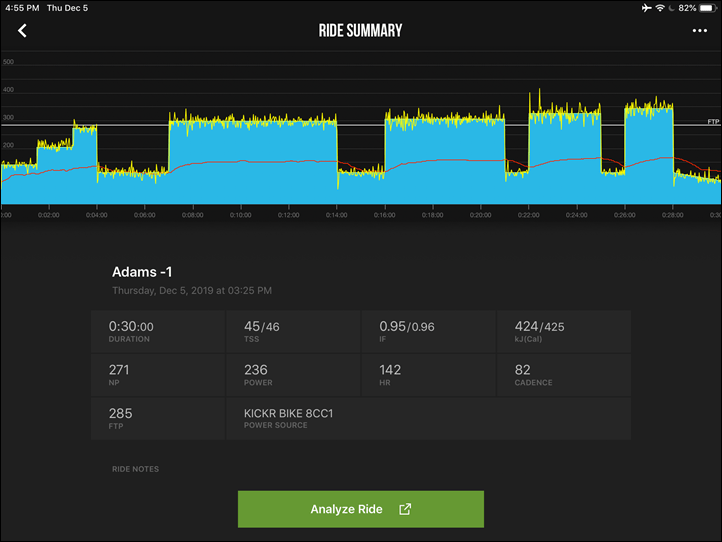
Once your workout is done it'll go to their online training log, plus to 3rd party apps like Strava and TrainingPeaks. Their online training and analysis platform has slowly grown over the last few years, and can pull in outside workouts too. I outlined more of it here. It's essentially like a mini-TrainingPeaks:
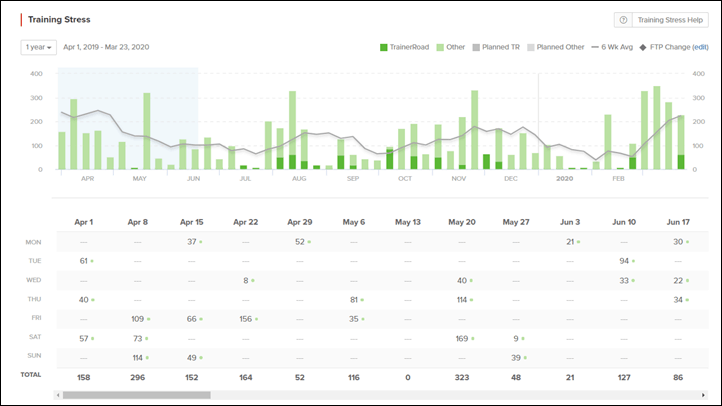
Speaking of outdoor workouts, you can take many of the structured workouts outside. So if you've got something on your schedule, there's options for a lot of them to convert them to outdoor workouts, which tweaks the formatting slightly to make them more viable in a real-world road scenario. Here's the same workout, at left for indoor, and at right toggled into outdoor mode (which you can then push to a Wahoo GPS computer):
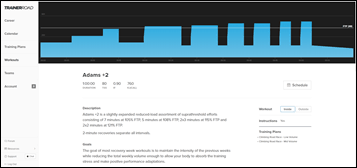
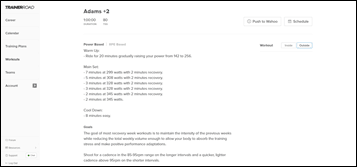
Finally, there's abilities within the training plans to account for life events like work travel or no-workout days due to family obligations. Again, these sound like little things, but simply put nobody else is doing this kind of stuff. These functions in total ultimately can provide a near-coach-like experience for people trying to plan out and execute their training and racing.
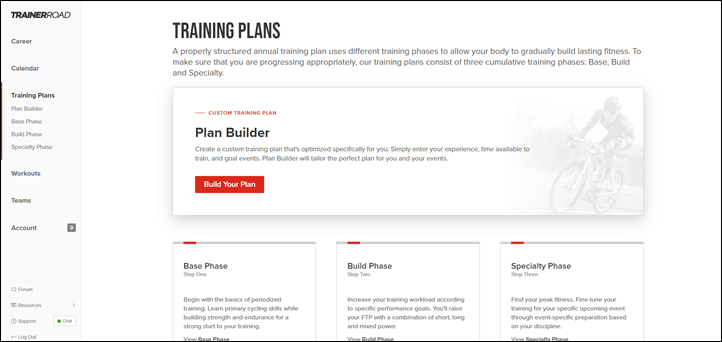
Which isn't to say coaches aren't valuable, they absolutely are. And they dispense knowledge and feedback about your workout and its execution that TrainerRoad doesn't at this point. But if you can't afford a coach, or if it doesn't fit into your preferences, this is a pretty good step.

The final reason they've got a cult-like following is their weekly 'Ask a Cycling Coach' podcast where they dive into all the nuances of training and racing with questions from users, and overwhelmingly deep dives into nuanced cycling topic areas. Plus their forums, where users trade tons of knowledge. Again, these might sound like things you skim over, but as any regular TrainerRoad user will tell you – the amount of knowledge in those two areas about how to actually get faster is astounding.
Still, the challenge TrainerRoad faces is the fact that it took me about 18 paragraphs to explain how extensive the platform is. The secondary problem they face is there isn't much instant gratification at this point. Compared to riding in Zwift which is visually mind-grabbing as well as has a social training and racing element, TrainerRoad is just staring at numbers on a screen. Now, as many of you know – I personally like that. But I'd love to see TrainerRoad figure out how to increase their social interaction on the platform for those that want it. Whether it be recorded workouts by a handful of coaches, or ways for users to interact with each other.
Nonetheless – if you're looking for a way to get faster in racing through science-backed training and structures, then it's hard to beat what TrainerRoad is offering. From the singular workouts all the way up to training plans that can be tweaked on the fly to deal with life events, the depth of what they have as a platform might be hard to see until you spend time with it. But it's there, you just gotta invest the sweat.
Xert:
In a lot of ways Xert is unlike any other app on this list. It's both a training app as well as a complete training log platform. Yes, TrainerRoad has some training analysis/logging, but Xert takes it to an entirely different level. Xert would see themselves (rightly so) more as a competitor to TrainingPeaks than anything else. But, they also see their entire indoor training app as critical to that. It's also the only app on this list that dynamically adjusts the workouts in real-time based on your progress through it.
It's also the only app on this list that's dynamically adjusting your FTP after every workout you do, no matter the source and without an FTP test. It just happens behind the scenes by looking at your actual data. See, you can hook-up your account to Strava, Garmin, Wahoo, and others, and it'll swallow all your data constantly behind the scenes and ensure that whatever trainer ride you do exactly matches your current fitness level. It's super cool, and I've written about the platform side in the past here.
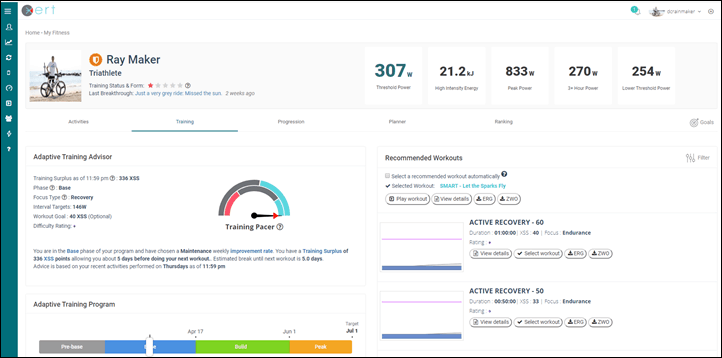
[Note: For this review section I'm using the new user interface which is set to go live any day now. I've used and pay for Xert for years, so I'm pretty familiar with how things work on the whole regardless of the new interface, but just figured I'd mention that to reduce confusion here until this is rolled out.]
But, this post isn't about training platforms. It's about trainer apps. Now in this case the company has an iOS and Android app, but not an iOS one optimized for iPad. They've also got a desktop variant too that you can actually run from a webpage. Pretty cool. In my case, I just used the iOS one on iPad anyway. Once you crack it open, you'll see your current history on the lower left tab, as well as some period stats on the aptly named 'stats' tab.
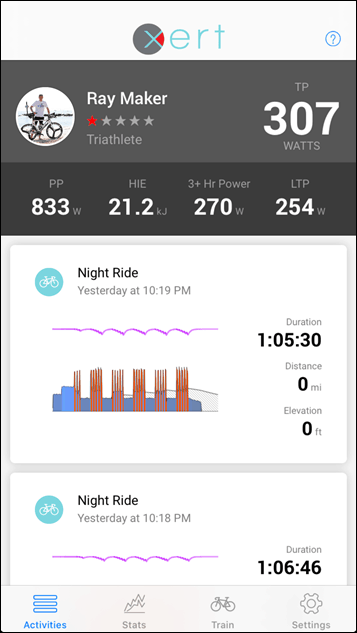
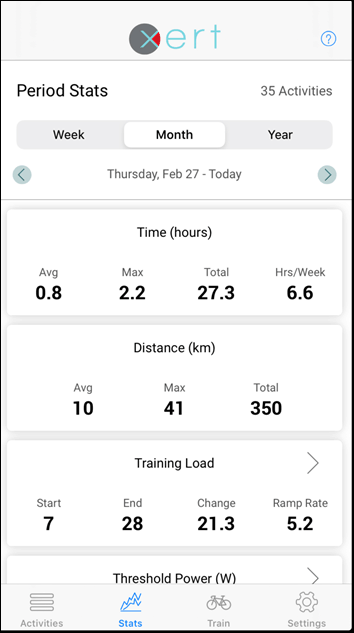
Next, there's a workout that's ready for me. It did this automatically as a recommendation, deciding what it believes is the best workout for my current situation. When I tap it, I can see a little bit more detail about the workout, including the MPA line in purple – which is showing me my maximal power available. MPA is a core metric in Xert and is kinda like Street Fighter health. If you do a hard sprint, your ability to keep on sprinting at 800w or 1,000w decreases over time. Specifically that you can't do that forever, and you see that below. Additionally, a significant effort will reduce your viable MPA over the rest of the workout.
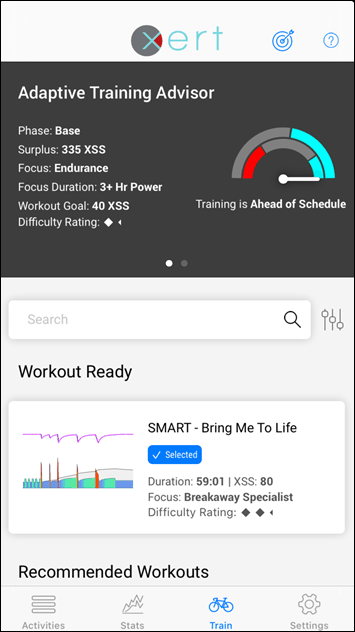
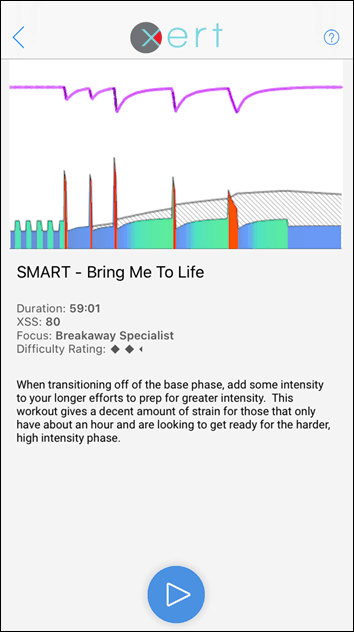
Alternatively, you can pick a different workout. The ones that have the words 'Smart' next to them are ones that are dynamic in nature, as we'll see in just a second. At that point, go ahead and pair it up to your sensors. Trainers, heart rate sensors, etc. – all the usual stuff you'd expect here.
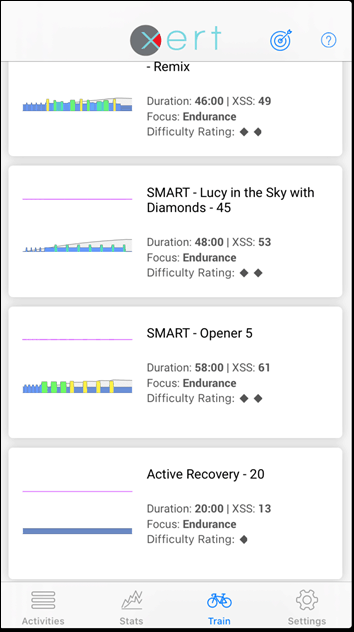

Now, once we hit start we'll get right into things. The top 1/3rd of the app has multiple pages you can swipe through, but the remainder largely stays as-is. If you look at these first two mini-pages, you'll see an overview of the workout, as well as my average power at this point in the workout (a mere 30 seconds into it.)
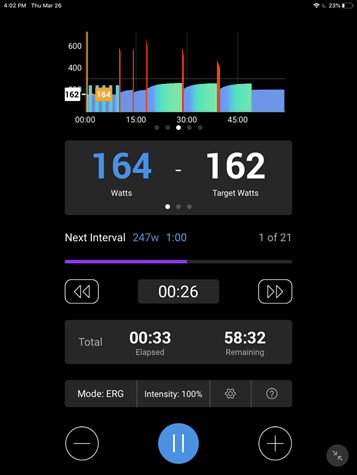
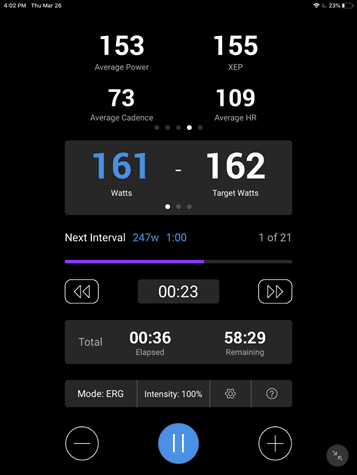
The next two mini-pages include a graph of effort and then available MPA, and then followed by that is the schedule of events in text format. In other words, what's coming up split-wise and power-wise, plus the estimated MPA available.
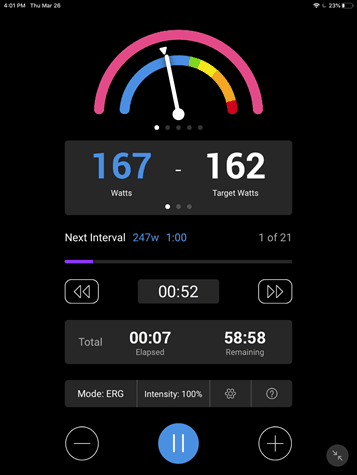
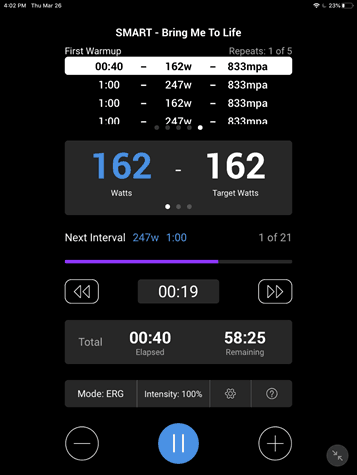
The workout will iterate through, automatically adjusting the power on your train accordingly. You can skip or go ahead in an interval by pressing the VCR-like buttons above. Or you can adjust intensity by pressing the +/- buttons. You can see your target and actual watts.
However, the key thing that separates Xert here is their smart workouts, which are dynamically adjusting. And as it would turn out (unexpectedly), this feature demonstrated itself perfectly to me. See, the day before I had done two hard interval workouts…one of them finishing up at midnight…followed by only a handful of hours of sleep.
Xert in theory knows what my targets should be, based on my bike efforts. But it doesn't at this point know my body state. So in some ways it was a bit optimistic. But how it changes mid-workout is pretty fascinating.
So, my warm-up and such went just fine, and then some light build, also just fine. And then it went into the first hard interval – which was targeted at 673w for 36 seconds. However, reality struck and my body (and legs) basically said 'No'. About half-way through the interval things fell apart. Just wasn't going to happen. However, as my failure occurred, you could see the app adjusting the intensity of the interval to try and give me a new realistic target.
I didn't have a series of screenshots for that, because…umm…I was trying not to die.
Instead though, for the next interval I screen recorded. This one was earlier on targeted for 25 seconds at 592w (seen left in the list at the top of the screen). However, as soon as I start the interval you'll see the actual duration has been cut to 18 seconds. Atop that, shortly into the interval it then reduces my target watts a bit further.
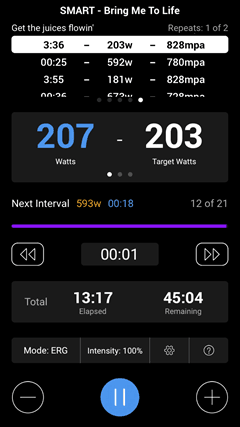
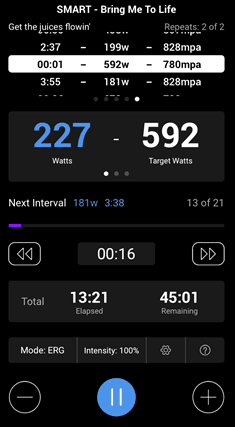
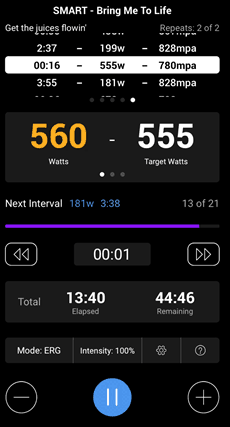
Now, some of you might say 'Well, maybe you could have made that interval with a bit more push?', maybe the app cut me off too early? And perhaps in some cases that could be true. Having used this feature occasionally over the years, I find it seems to do a good job at figuring out what's viable vs not viable. So why would it have scheduled me to do something I couldn't have done?
Well, there's likely two reasons. First is that I had recorded on multiple devices that ended up syncing into the app that I hadn't gotten rid of yet – so it thought my load was higher than reality (and thus my capabilities). But realistically, I probably could have hit that interval set…if I had more than 3-4 hrs of sleep the night before and hadn't been doing 1-2 trainer workouts a day for the last 7-10 days doing app testing. My body is shot, and this was basically the final straw.
But I think it's just so cool to watch it all happen in real-time. It's almost like having a coach on the sidelines yelling at you to concurrently keep it up, while adjusting the goal to something realistic.
Finally, it's worth noting that you can actually take Xert workouts and export them to Zwift ZWO files, so you can blend this platform as the backend for your training, but execute things in Zwift. You won't get the dynamic smarts changing aspect of doing it within the Xert Workout Player, but you do get the customized targets based on the data you upload into the Xert online platform.
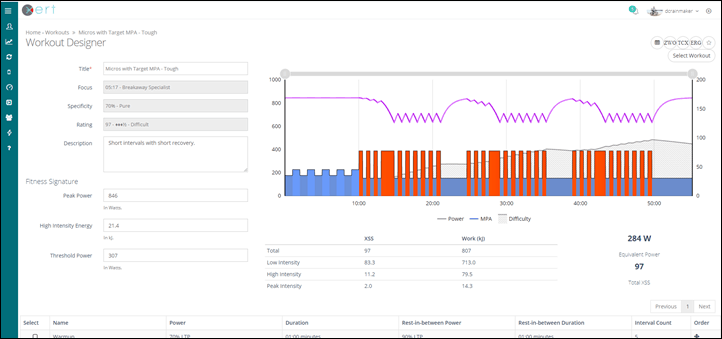
Xert is cool stuff, and I think using it as a trainer app makes sense for folks that want a full training platform for their workouts. Meaning, I don't think there's going to be too many people that just use Xert by itself for their trainer (though, absolutely you can, their workout library rivals many apps here). Instead, I think the key benefit of Xert is using their training platform to consolidate all your workout data into, and letting it drive your workouts and the associated intensity and structure around it.
Zwift:
With somewhere in the 300K subscriber range, Zwift is the largest of the indoor training platforms (save Peloton, which sits at over 700,000 subscribers). But that's Peloton users with a bike (app-only is much smaller at ~110,000 users), versus Zwift and the other apps here work with any device. I recognize that like McDonald's or Subway, most of you know what Zwift is, and if you do – you probably won't learn much from this section. That's why there's 10 other sections to read.
Zwift is a massive online cycling sports game and training app. I use the term game, because Zwift does as well. Gamification is part of it, though, not inherently required to enjoy it. You can ride Zwift entirely in your own little bubble ignoring virtually all gamification aspects if you wish. But ultimately, it's the social nature of seeing thousands of other riders buzzing around you that brings Zwift alive. There are no bots here or fake riders, everyone you see is real [Update Sept 2020: There are now bots. Four, to be precise. Basically acting as group rides. It's actually cool.]
With that, there are at present six worlds within Zwift. Most of these are modeled after real places (like Innsbruck, Yorkshire, Richmond, New York City, and Bologna TT course), while the expansive 'Watopia' is a fictional island that includes a variety of terrain, some of it replicating real-world locales (notably, Alpe d'Huez). You can always ride Watopia, and then each day one of the other worlds is offered as a 'Guest World'. You can further use various hacks/workarounds to ride any world you want anytime. The idea being to ensure that each world has plenty of people riding it. The app connects to every smart trainer or dumb trainer on earth. If a trainer doesn't work with Zwift, you don't want to be riding it.
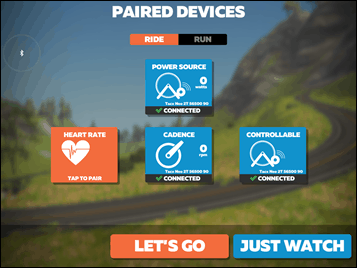
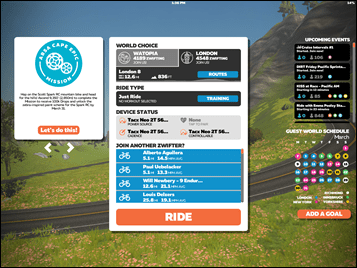
When you choose your world for the day, you can select a given route, or you can free-style it. In either scenario, you can always use the smartphone companion app or a keyboard to change directions to different roads. On some courses there are just a handful of roads/routes (like Richmond, Yorkshire, or Innsbruck). Whereas with Watopia, you could probably ride for probably close to a day without repeating a route. Here's a listing of all worlds and all routes.
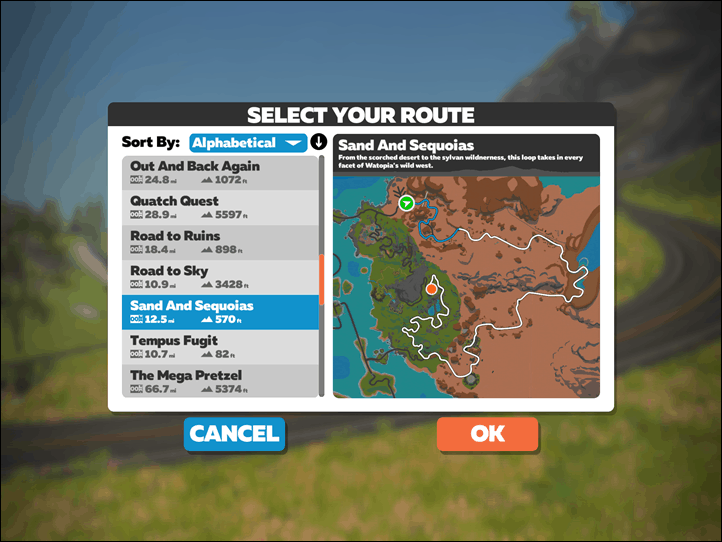
In addition to choosing a world, Zwift also offers both structured workouts and training plans. These can be selected from within the menu. There are boatloads of workouts, though the app doesn't really have good filtering. For example, you can select a time-duration, but that won't actually pull all the workouts from within the training programs. So basically, you see a tiny fraction of the available workouts. When it comes to training plans, they often lack cohesion and specificity, especially compared to TrainerRoad. Still, you can usually find something in there to keep you busy, and like most training plans – doing almost anything for weeks or months at a time will make you stronger.

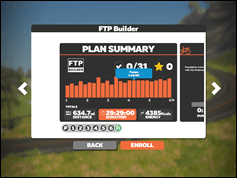

However, some of the 3rd party workouts are better, but again, they don't show up in the plans section (despite being plans), so it doesn't automatically prompt you to ride it on the correct day of the week like the plans do. Also, for lack of anywhere else to put it – the companion app's structured workout controller is really quite good.

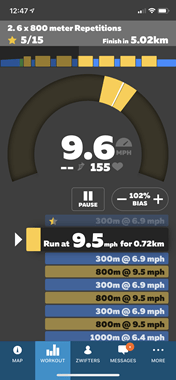
With that, into the game we go. The resistance on your trainer is controlled by Zwift (assuming a smart trainer). As you go up climbs, it'll change the resistance accordingly. Your speed in the game is normalized across all competitors using your weight. It's critical your weight is inputted correctly, so that the correct watts/kilogram can be computed. That one sentence alone has piles and piles of pieces written about it. You'll see others riding around you, though larger group rides and races aren't always shown to prevent the game from being visually overloading (primarily on your computer's graphics processor).
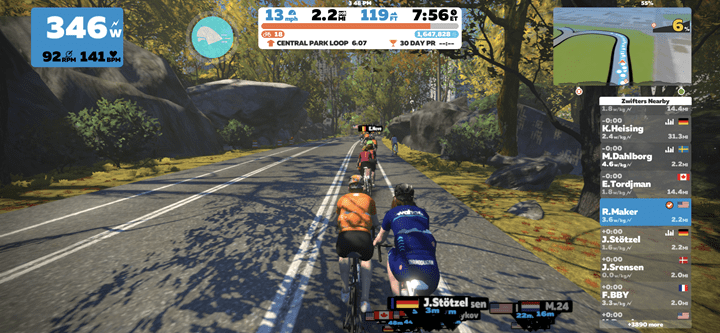
Speaking of which, you can run Zwift on basically any platform. I personally run it almost exclusively on Apple TV. Save the occasional iPad session. I think Zwift on Apple TV is probably the best bang for the buck out there today. The 'just works' factor is usually pretty high, and the graphics using the Apple TV 4K version are more than fine for me (note: even if you don't have a 4K TV, get the 4K variant for the extra $20, it's got substantially more graphical power inside). The screenshots below are all simply Apple TV 4K (whereas the one above is from my iPhone):
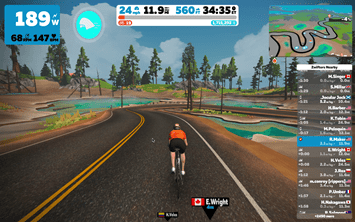
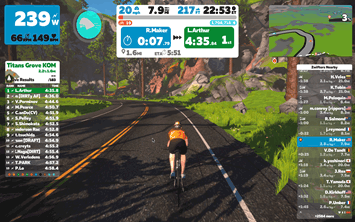
When it comes to group rides or races, anywhere from 50-150+ events per day depending on all sorts of factors (recently, boatloads). Numerous per hour, which you can easily look-up using the Zwift companion app, or a pile of 3rd party sites. Generally speaking, group rides stick together and have defined leaders and pace groups – just like in the real world. Whereas races hurt just like they do outside, again, with various categories based on your FTP.
I occasionally do both group rides and races, though as you'll quickly learn in Zwift – it's rarely about trying to win, and more about getting a good workout that keeps you driving forward. The social element of knowing you're racing or riding against a real person versus a bot is a key differentiator here. As is the fact that you can attempt to use your phone or keyboard to chat in real-time with people.
Oh – and there's even mountain biking too. Albeit, it's only about 7-10 mins long, but undoubtedly we'll see it expand.

And atop that, there's running too. I know, most of you reading this probably aren't runners, but still, it's there for ya. And the new track is pretty cool.
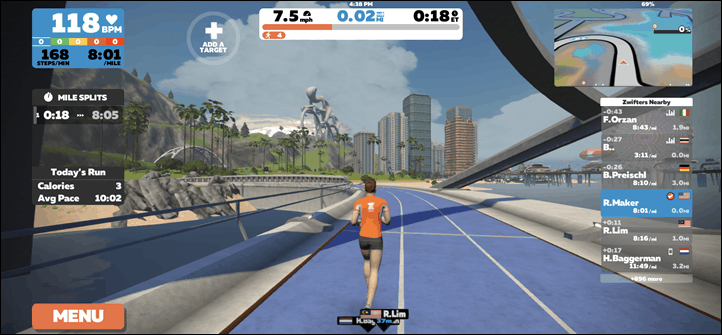
When it comes to indoor cycling apps, Zwift is clearly the big dog within the serious cycling realm (again, Peloton put slightly aside for a moment). And for the most part, Zwift does an exceptionally good job at both driving and supporting the community, as well as offering numerous ways to keep yourself busy. Whether that be in a structured 'Tour of Something' type event series that's always going on, or via structured workouts. Heck, even runners can plod along in Zwift. But you don't need to be part of some overarching series or event, you can just jump on and ride – which is often how I use it.
The challenges Zwift has are common to almost any massive online gaming platform – the more people you get in, the more obvious some of the cracks become. Cheating continues to be a legit and real issue for Zwift racing, though they are taking steps to address that. Some people won't care about that, and that's fine. Zwift also tends to prioritize social & marketing advancements over technological ones. You'll generally see almost every other app on this list roll out new technology/trainer support before Zwift, and usually do it in a smoother/better way too. Hopefully Zwift's newly formed hardware group will try and address that longer term.
Still, it's hard to beat Zwift. The user interface is simple and easy to use, and there's always something going on. It's like walking into a carnival – you might not know what you want to do or your plan is when you walk through the gates, but by the end of your stay you definitely did something. There's a bit of something for everyone, it's up to you what to make of it.
Finally, the best resource out there for all things Zwift is ZwiftInsider.com. If you've ever wondered about something, and then thought 'Why am I wondering about this?" – then ZwiftInsider likely has more detail than you ever initially wondered about.
Favorite Trainer Accessories:
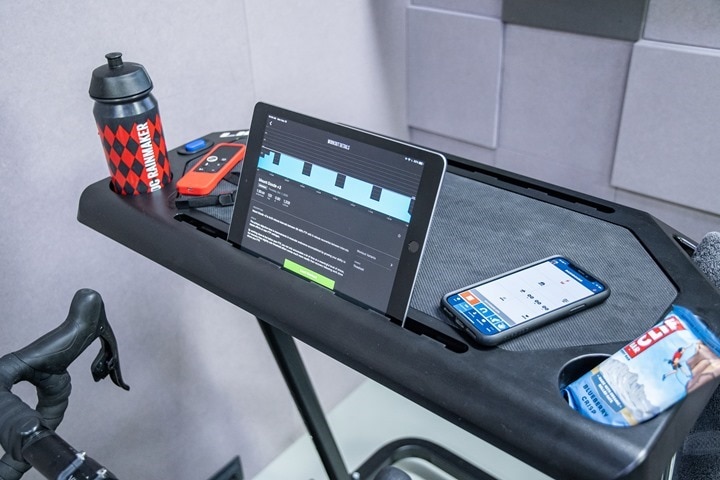
People always ask my favorite trainer accessories, and these are the ones that I use most frequently/daily. I'm a simple person in that respect, I typically don't need the fanciest versions of these things. I'm happy with a $10-$20 trainer mat, a $7 front wheel block, and the cheaper trainer desk. Also, I've been using that fan listed below for a few months – both the US variant (Lasko), and the EU/UK variant (Vacmaster). If you're in the UK/EU, you'll get the correct one when you click on it automatically.
| Product | Amazon | Note | |
|---|---|---|---|
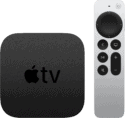 | Apple TV 4K (2021 Edition) | Amazon | There's no better bang for your buck in getting Zwift (or FulGaz/etc) on your big screen TV than Apple TV - it's the primary way I Zwift. Even if you don't have a 4K TV, the 4K version has more powerful graphics than the base, worth the extra $30. |
 | Basic Trainer Mat | Amazon | This is a super basic trainer mat, which is exactly what you'll see me use. All it does is stop sweat for getting places it shouldn't (it also helps with vibrations too). |
 | Elago R1 Apple TV Remote Silicone Case with Strap | Amazon | I use Apple TV for Zwift the vast majority of the time, but also just for watching YouTube/Netflix/etc on the trainer. The Apple TV remote sucks though. This $8 case fixes that, it's a silicone strap that makes it easy to grab, but also has a strap to easily place on the edge of your handlebars. Boom! Note: Not compatible with 2021 Apple TV Edition. |
 | Front Wheel Riser Block | Amazon | Here's the thing, some people like front wheel blocks, some don't. I'm one of the ones that do. I like my front wheel to stay put and not aimlessly wiggle around. For $8, this solves that problem. Note some trainers do come with them. Also note, I use a riser block with *every* trainer. |
 | Honeywell HT-900 Fan | Amazon | I've got three of these $12 fans floating around the DCR Cave, and I frequently use them on rides. They work just fine. Sure, they're not as powerful as a Wahoo Headwind, but I could literally buy 20 of them for the same price. |
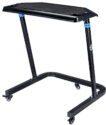 | Indoor Cycle Trainer Desk (RAD/Lifeline/Vinsetto/Conquer/etc...) | Amazon | This desk is both a knock-off of the original KICKR Desk, but yet also better than it. First, it's got wheel locks (so the darn thing stays put), and second, it has two water bottle holders (also useful for putting other things like remotes). I've been using it as my main trainer desk for a long time now and love it. Cheaper is better apparently. Note: Branding varies by country, exact same desk. |
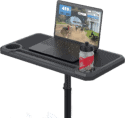 | KOM Cycling Trainer Desk | Amazon | This is by far the best value in trainer desks, at only $59, but with most of the features of the higher end features. It's got multi-tier tablet slots, water bottle holders, non-stick surface, adjustable height and more. I'm loving it! |
 | Lasko High Velocity Pro-Performance Fan (U15617) | Amazon | One of the most popular trainer fans out there, rivaling the Wahoo Headwind fan in strength but at a fraction of the price. It doesn't have smartphone/ANT+/Bluetooth integration, but it does have secondary outlets. I've been using it, and a similiar European version lately with great success (exact EU variant I use is automatically linked at left). |
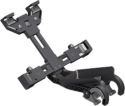 | Tacx Tablet Bike Mount | Amazon | I've had this for years, and use it in places where I don't have a big screen or desk, but just an iPad or tablet on my road bike bars. |
Wrap-Up:
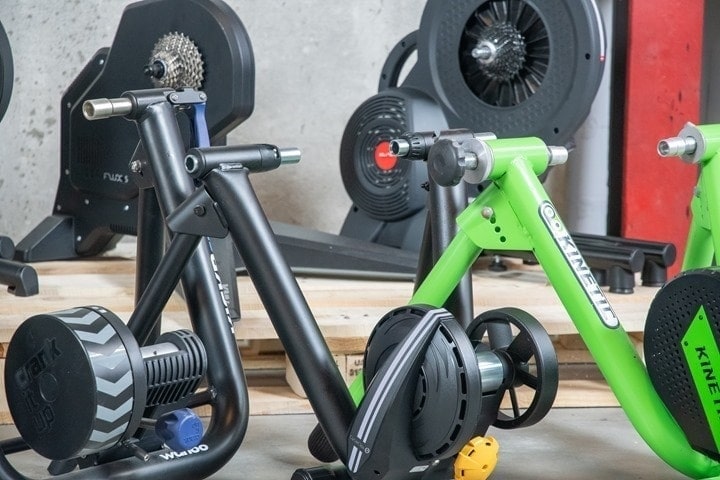
Phew, I made it. Or, we made it. I don't know – it's time for ice cream.
Here's the thing – different people want different types of apps, or even different implementations. Someone who loves Zwift might hate The Sufferfest. Or someone who loves Kinomap might dislike Rouvy, despite being similar apps. You really just need to play the field a bit and try apps, perhaps apps you hadn't considered. If you like Zwift, then give RGT a go. If you like TrainerRoad, then you might like The Sufferfest. If you like the coached elements of The Sufferfest, it's actually quite likely you'll like the power zone workouts of some Peloton instructors. And if you like the Tacx Training App, then you'll probably like FulGaz.
To that end, what I like personally isn't super important. My criteria for the apps I use are both more simplistic and probably a bit geek laden. The two main apps I use year-round are Zwift & TrainerRoad. They're my go-to's. My next favorite apps I wish I used more would be The Sufferfest and FulGaz – I think both of those have nailed execution. I also use Peloton weekly, but on a Peloton Bike, which is much more data-laden (and then better to me), than the Peloton app. But again, that's just me.
If you found this whole beast of a round-up useful, that's great! That means I can avoid doing one for at least another 2-3 years, right? But seriously, if so, this took waaaaay more time than I thought it would. Even sorting, consolidating, and inserting just the photos into this post took over 6 hours. So if you did find it useful – hit up the links on the sidebar (such as Amazon) or consider becoming a DCR Subscriber. I appreciate it!
Is There A Way To Get Rid Of The Ads On The Magic Puzzle App
Source: https://www.dcrainmaker.com/2020/03/cycling-indoor-trainer-app-guide.html
Posted by: mclawhornapigh1968.blogspot.com

0 Response to "Is There A Way To Get Rid Of The Ads On The Magic Puzzle App"
Post a Comment